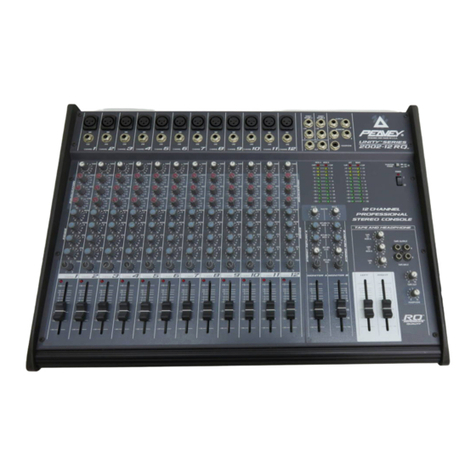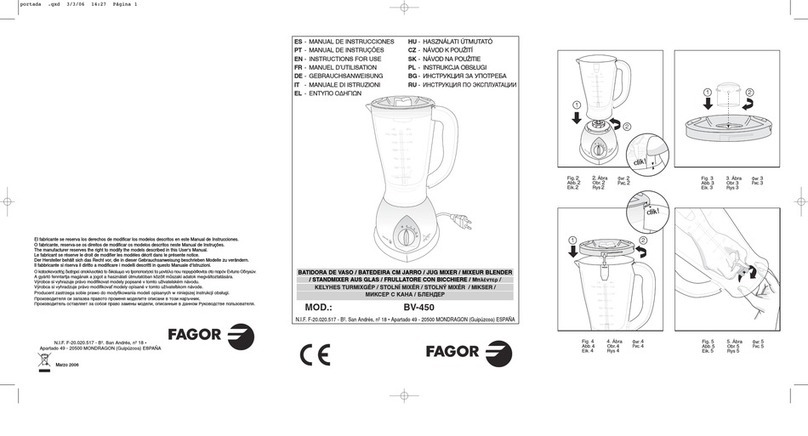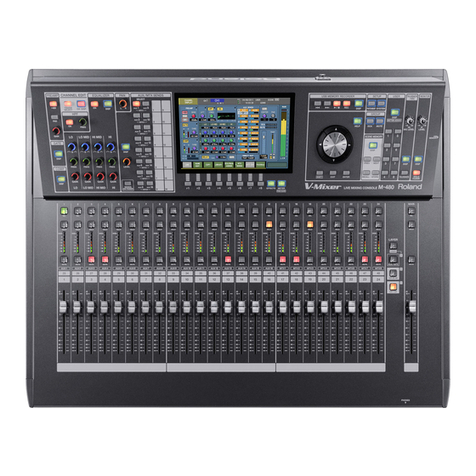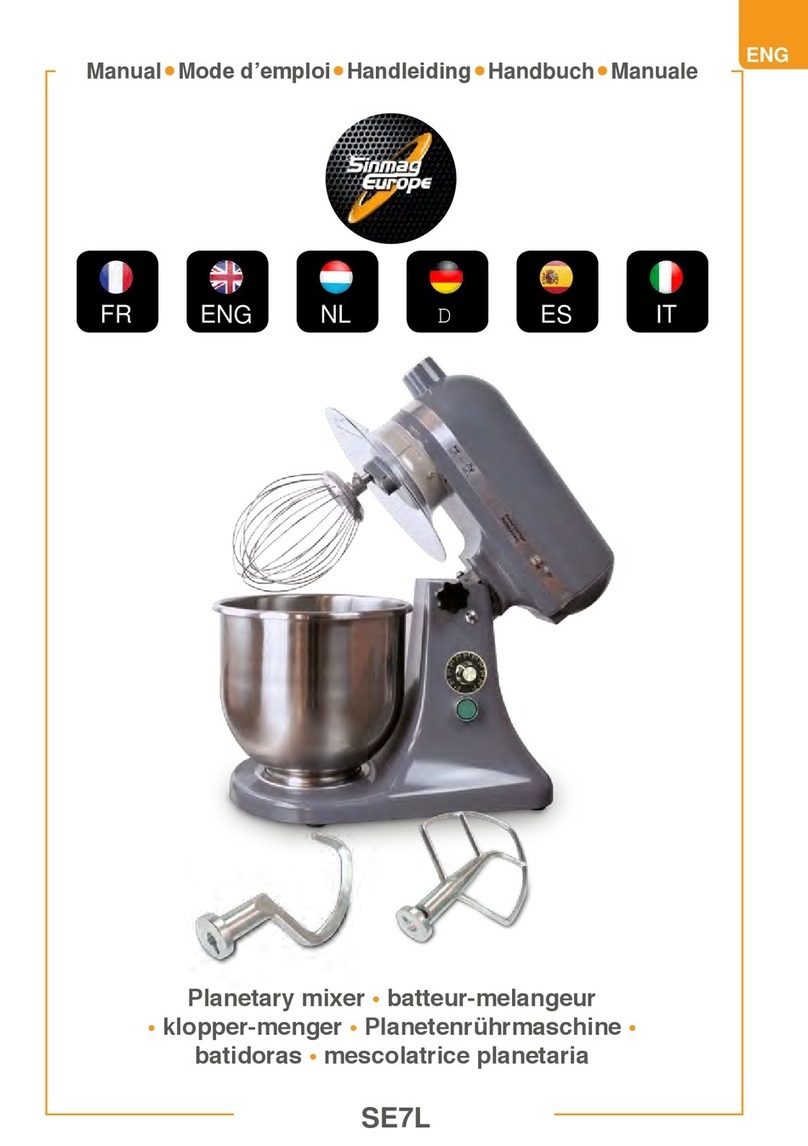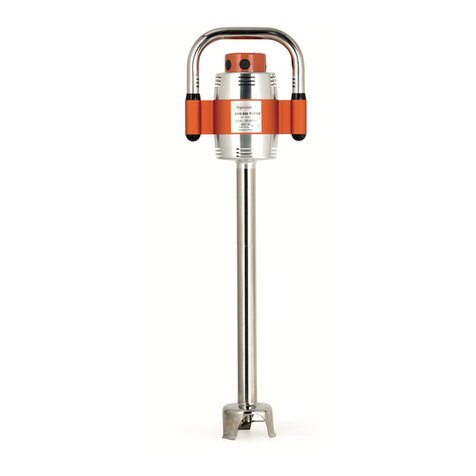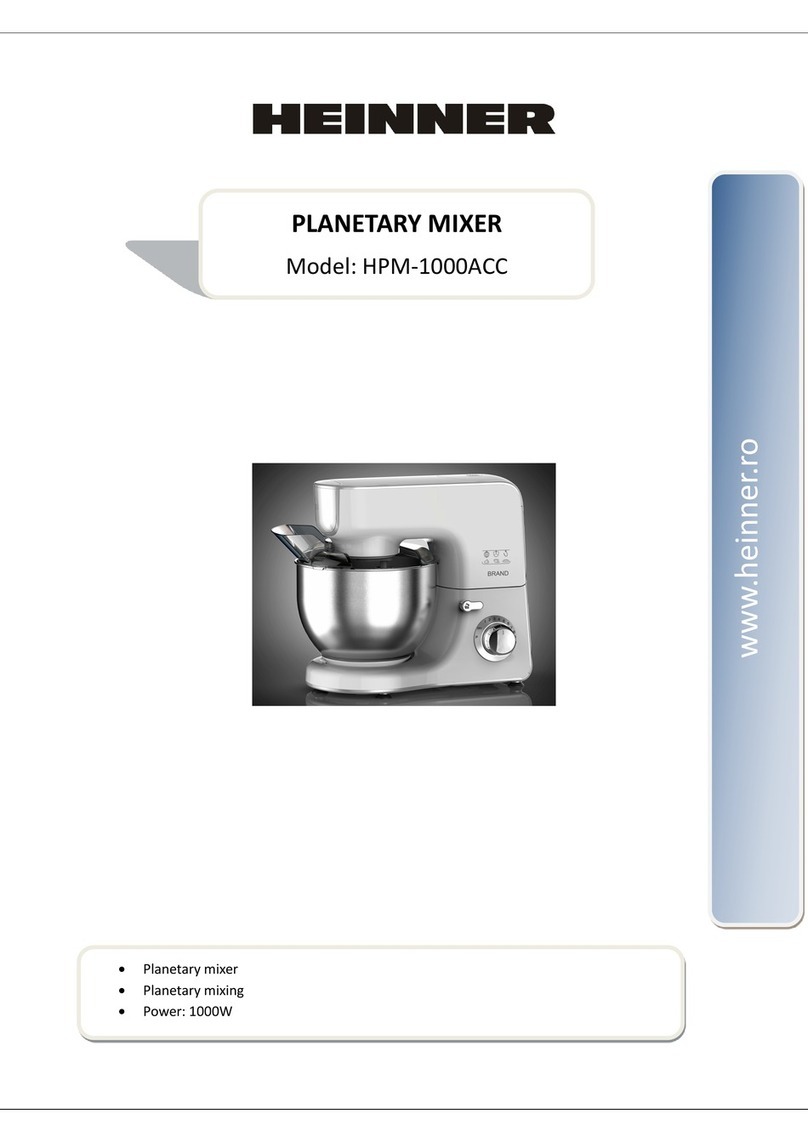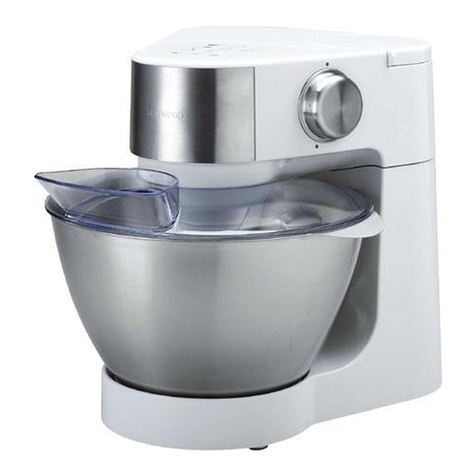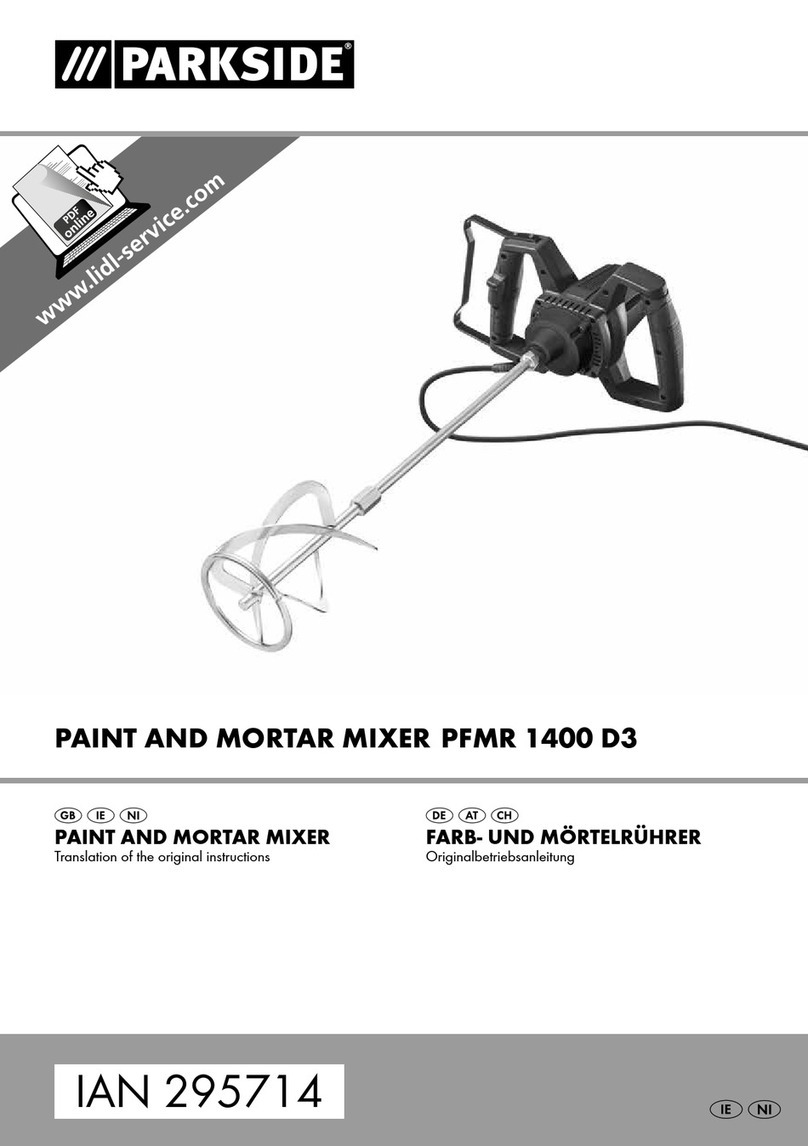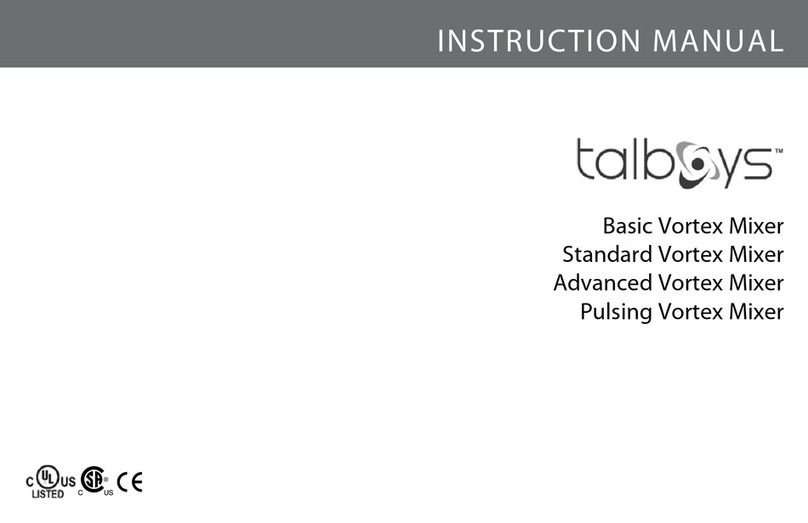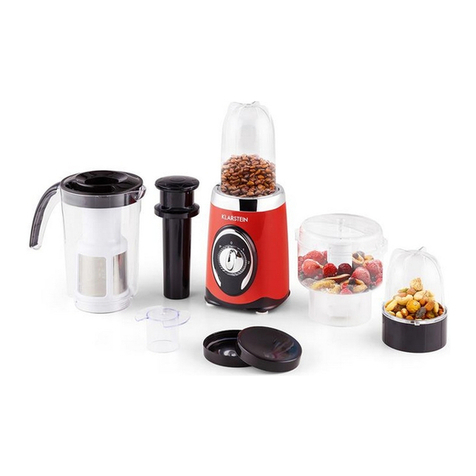IMG STAGE LINE MPX-210 User manual

Stage LineR
MPX-210
STEREO
PRO MIXER
R
GAIN
-10 +10
HIGH
0
-10 +10
MID
0
-10 +10
BASS
0
GAIN
-10 +10
HIGH
0
-10 +10
MID
0
-10 +10
BASS
0
-10 +10
HIGH
0
-10 +10
MID
0
-10 +10
BASS
0
GAIN
0
5
10
GAIN
0
5
10
CUE CUE
-10 +10
HIGH
0
-10 +10
MID
0
-10 +10
BASS
0
GAIN
0
5
10
GAIN
0
5
10
CUE CUE
CUE O/P
SELECT
010
5
LEVEL
AUTO TALK AUTO TALK
ON AIR ON AIR BASS MID HIGH BASS MID HIGH
TRIGGER
PHONES
MIC 2 CH 1 CH 2 CH 3 CH 4
+EQ+EQ
LINE
/
CD LINE
/
PHONO LINE
/
CDLINE
/
PHONO
ECLIPSE
LEFT RIGHT
+5
+3
+1
0
-1
-3
-5
-7
-10
-20
MASTER
LEFT
010
5
010
5
RIGHT
MIN MAX MIN MAX MIN MAX MIN MAX MIN MAX MIN MAX
KILL TRIGGER
SUPER X FADER
CH 3/4CH 1/2
010
100
KILL
LAMP
12V/5W
POWER
MIC 1
BEDIENUNGSANLEITUNG • INSTRUCTION MANUAL • MODE D’EMPLOI
ISTRUZIONI PER L’USO • GEBRUIKSAANWIJZING • HANDLEIDING
MANUAL DE INSTRUCCIONES • MANUAL DE INSTRUÇÕES
BRUGSANVISNING • BRUKSANVISNING • KÄYTTÖOHJE
STEREO-DISCO-MISCHPULT
STEREO DISCO MIXER
TABLE DE MIXAGE STEREO POUR DISCOTHEQUE
MIXER STEREO PER DISCOTECA
MPX-210 Best.-Nr. 20.0980

2
Voordat u inschakelt ...
Wij wensen u veel plezier met uw nieuw toestel
van “img Stage Line”. Met behulp van bijgaande
gebruiksaanwijzing zal u alle functiemogelijkhe-
den leren kennen. Door deze instructies op te
volgen zal een slechte werking vermeden wor-
den, en zal een eventueel letsel aan uzelf en
schade aan uw toestel tengevolge van onzorg-
vuldig gebruik worden voorkomen.
U vindt de nederlandstalige tekst op de pagina’s
16
-
18.
NL
B
Bevor Sie einschalten ...
Wir wünschen Ihnen viel Spaß mit Ihrem neuen
Gerät von „img Stage Line“. Dabei soll Ihnen die-
se Bedienungsanleitung helfen, alle Funktions-
möglichkeiten kennenzulernen. Die Beachtung
der Anleitung vermeidet außerdem Fehlbedie-
nungen und schützt Sie und Ihr Gerät vor even-
tuellen Schäden durch unsachgemäßen Ge-
brauch.
Den deutschen Text finden Sie auf den Seiten
4
-
6.
D
A
CH
Before you switch on ...
We wish you much pleasure with your new “img
Stage Line” unit. With these operating instruc-
tions you will be able to get to know all functions
of the unit. By following these instructions false
operations will be avoided, and possible dam-
age to you and your unit due to improper use
will be prevented.
You will find the English text on pages 7
-
9.
Avant toute mise en service ...
Nous vous remercions d’avoir choisi un appareil
“img Stage Line” et vous souhaitons beaucoup
de plaisir à l’utiliser. Cette notice a pour objectif
de vous aider à mieux connaître les multiples
facettes de l’appareil et à vous éviter toute mau-
vaise manipulation.
La version française se trouve pages 10
-
12.
F
B
CH
Prima di accendere ...
Vi auguriamo buon divertimento con il Vostro
nuovo apparecchio “img Stage Line”. Le istru-
zioni per l’uso Vi possono aiutare a conoscere
tutte le possibili funzioni. E rispettando quanto
spiegato nelle istruzioni, evitate di commettere
degli errori, e così proteggete Voi stessi, ma
anche l’apparecchio, da eventuali rischi per uso
improprio.
Il testo italiano lo potete trovare alle pagine 13
-
15.
I
Antes de cualquier instalación
Tenemos de agradecerle el haber adquirido un
equipo “img Stage Line” y le deseamos un agra-
dable uso. Este manual quiere ayudarle a cono-
cer las multiples facetas de este equipo y evitar
cualquier uso inadecuado.
La versión española se encuentra en las páginas
19
-
21.
Inden De tænder for apparatet ...
Vi ønsker Dem god fornøjelse med Deres nye
“img Stage Line” apparat. Denne brugsanvisning
giver mulighed for at lære alle apparatets funktio-
ner at kende. Følg vejledningen for at undgå for-
kert betjening og for at beskytte Dem og Deres
apparat mod skade på grund af forkert brug.
Den danske tekst finder du på side 25
-
27.
DK
E
P
S
FIN
Antes de pôr em funcionamento ...
Agradecemos-lhe por ter escolhido um aparelho
“img Stage Line”. Com estas instruções ficará
habilitado a conhecer e utilizar todas as funções
desta unidade. Seguindo-as, evita possíveis
manipulações defeituosas.
A versão em idioma português pode ser en-
contrada nas páginas 22
-
24.
Förskrift
Vi önskar dig mycket nöje med din nya MPX-210.
Om du först läser instruktionerna kommer du att
glädje av enheten under lång tid. Kunskap om
alla funktioner kan bespara dig mycket besvär
med enheten i framtiden.
Du finner den svenska texten på sidan 28
-
30.
Ennen virran kytkemistä ...
Toivomme, että uusi “img Stage Line”-laitteesi
tuo sinulle paljon iloa ja hyötyä. Tämä käyt-
töohje esittää sinulle kaikki uuden laitteesi toi-
minnot. Seuraamalla sitä vältät virhetoiminnot ja
niistä johtuvat mahdolliset vahingot sinulle tai
laitteellesi.
Löydät suomenkieliset käyttöohjeet sivuilta
31
-
33.
GB

3
➁
MPX-210
STEREO
PRO MIXER
R
GAIN
-10 +10
HIGH
0
-10 +10
MID
0
-10 +10
BASS
0
GAIN
-10 +10
HIGH
0
-10 +10
MID
0
-10 +10
BASS
0
-10 +10
HIGH
0
-10 +10
MID
0
-10 +10
BASS
0
GAIN
0
5
10
GAIN
0
5
10
CUE CUE
-10 +10
HIGH
0
-10 +10
MID
0
-10 +10
BASS
0
GAIN
0
5
10
GAIN
0
5
10
CUE CUE
CUE O/P
SELECT
010
5
LEVEL
AUTO TALK AUTO TALK
ON AIR ON AIR BASS MID HIGH BASS MID HIGH
TRIGGER
PHONES
MIC 2 CH 1 CH 2 CH 3 CH 4
+EQ+EQ
LINE
/
CD LINE
/
PHONO LINE
/
CDLINE
/
PHONO
ECLIPSE
LEFT RIGHT
+5
+3
+1
0
-1
-3
-5
-7
-10
-20
MASTER
LEFT
010
5
010
5
RIGHT
MIN MAX MIN MAX MIN MAX MIN MAX MIN MAX MIN MAX
KILL TRIGGER
SUPER X FADER
CH 3/4CH 1/2
010
100
KILL
LAMP
12V/5W
POWER
MIC 1
12 3 4 5 678
91011 121314 1516 1718
➀
OUTPUT CH 4 CH 3 CH 2 CH 1
MIC 2 MIC 1
REC AMP LINE CD LINE CD LINE PHONOLINE PHONO
L
R
L
R
L
R
L
R
L
R
230V~/50Hz
GND
L
R
19 20 21 22 23 24 25

D
A
CH
4
Bitte klappen Sie die Seite 3 heraus. Sie sehen
dann immer die beschriebenen Bedienelemente
und Anschlüsse.
1 Übersicht der Bedienelemente und
Anschlüsse
1.1 Frontseite
13fache Klangregelung (Equalizer) für die Mikrofon-
kanäle; bestehend aus Tiefenregler (BASS), Mit-
tenregler (MID) und Höhenregler (HIGH)
2Umschalttasten für die Eingänge der Kanäle
CH1
-
CH4
Taste nicht gedrückt:
Line-Pegel (LINE)
Taste gedrückt:
Phono-Pegel (PHONO) für CH1 und CH3
Line-Pegel (CD) für CH2 und CH4
33fache Klangregelung (Equalizer) für die Kanalgrup-
pe CH1/CH2 und die Kanalgruppe CH3/CH4;
bestehend aus Tiefenregler (BASS), Mittenregler
(MID) und Höhenregler (HIGH)
4Regler GAIN zum Einstellen der Eingangsverstär-
kung für die Kanäle CH1
-
CH4 und die beiden
Mikrofonkanäle
5VU-Meter
6BNC-Buchse LAMP zumAnschluß einer Pultleuchte
(12V/5W max.)
7Ein-/Ausschalter
86,3-mm-Klinkenbuchse PHONES zum Anschluß
eines Stereo-Kopfhörers (Impedanz ≥8Ω)
9Tasten ON AIR zum Ein-/Ausschalten des Mikro-
fons an Kanal MIC1 bzw. MIC2
10 TastenAUTO TALK zum Ein-/Ausschalten der Talk-
over-Funktion: Bei gedrückter Taste werden bei Mi-
krofondurchsagen an Kanal MIC1 bzw. MIC2 die
Pegel der übrigen Eingangskanäle automatisch um
15dB abgesenkt.
11 Tasten CUE zumAbhören der einzelnen Eingangs-
kanäle CH1
-
CH4 über einen Kopfhörer
12 Überblendregler (Crossfader) zum Überblenden
zwischen den beiden Kanalgruppen CH1/CH2
und CH3/CH4
13 Tasten KILL für die Kanalgruppe CH1/CH2 und
die Kanalgruppe CH3/CH4: Bei gedrückten Tas-
ten werden für die jeweilige Kanalgruppe die Hö-
hen (Taste HIGH), die Mitten (Taste MID) und die
Tiefen (Taste BASS) unterdrückt.
14 Taste TRIGGER für die Kanalgruppe CH1/CH2
und die Kanalgruppe CH3/CH4: zum kurzzeitigen
Einblenden der mit dem Crossfader (12) ausge-
blendeten Kanalgruppe
15 Lautstärkeregler (Fader) für die Eingangskanäle
CH1
-
CH4
16 linker (LEFT) und rechter (RIGHT) Summenregler
17 Überblendregler SELECT für den Kopfhöreraus-
gang: Bei Drehen des Reglers nach links wird der
mit der Taste CUE (11) angewählte Eingangskanal
eingeblendet, bei Drehen des Reglers nach rechts
die Stereo-Summe vor den Summenreglern (16).
18 Lautstärkeregler LEVEL für den Kopfhörer an
Buchse (8)
1.2 Rückseite
19 Netzkabel zum Anschluß an 230V~/50Hz
20 Cinch-Ausgangsbuchsen REC für denAnschluß ei-
nes Tonaufnahmegerätes; der Aufnahmepegel ist
unabhängig von der Stellung der Summenregler
(16)
21 Cinch-Ausgangsbuchsen AMP für den Anschluß
eines Verstärkers
22 Cinch-Eingangsbuchsen LINE bzw. CD für die Ka-
näle CH1
-
CH4 zum Anschluß von Geräten mit
Line-Pegel (z.B. Tuner, CD-Spieler, Kassettenre-
corder)
23 Cinch-Eingangsbuchsen PHONO für die Kanäle
CH1 und CH3 zum Anschluß von Plattenspielern
mit Magnetsystem
24 6,3-mm-Klinkenbuchsen zum Anschluß von Mono-
Mikrofonen an die Kanäle MIC1 und MIC2
25 Anschluß GND für gemeinsamen Massepunkt,
z.B. für Plattenspieler
2 Hinweise für den sicheren Gebrauch
Dieses Gerät entspricht der Richtlinie für elektroma-
gnetische Verträglichkeit 89/336/EWG und der Nie-
derspannungsrichtlinie 73/23/EWG.
Das Gerät wird mit lebensgefährlicher Netzspannung
(230 V~) versorgt. Nehmen Sie deshalb niemals
selbst Eingriffe im Gerät vor. Durch unsachgemäßes
Vorgehen besteht die Gefahr eines elektrischen
Schlages. Außerdem erlischt beim Öffnen des Gerä-
tes jeglicher Garantieanspruch.
Beachten Sie auch unbedingt die folgenden Punkte:
●Das Gerät ist nur zur Verwendung in Innenräumen
geeignet. Schützen Sie es vor Feuchtigkeit und Hit-
ze (zulässiger Einsatztemperaturbereich 0
-
40°C).
●Nehmen Sie das Gerät nicht in Betrieb, bzw. ziehen
Sie sofort den Netzstecker aus der Steckdose, wenn:
1. sichtbare Schäden am Gerät oder an der Netzan-
schlußleitung vorhanden sind,
2. nach einem Sturz oder ähnlichem der Verdacht
auf einen Defekt besteht,
3. Funktionsstörungen auftreten.
Lassen Sie das Gerät in jedem Fall in einer Fach-
werkstatt reparieren.
●Eine beschädigte Netzanschlußleitung darf nur
durch den Hersteller oder durch eine autorisierte
Fachwerkstatt ersetzt werden.
●Ziehen Sie den Netzstecker nie an der Zuleitung aus
der Steckdose.
●Wird das Gerät zweckentfremdet, nicht richtig ange-
schlossen, falsch bedient oder nicht fachgerecht re-
pariert, kann für eventuelle Schäden keine Haftung
übernommen werden.
●Verwenden Sie für die Reinigung nur ein trockenes,
weiches Tuch, niemals Wasser oder Chemikalien.
●Soll das Gerät endgültig aus dem Betrieb genom-
men werden, übergeben Sie es zur Entsorgung
einem örtlichen Recyclingbetrieb.

D
A
CH
5
3 Einsatzmöglichkeiten
Das Stereo-Disco-Mischpult MPX-210 mit vier Stereo-
Eingangskanälen und zwei Mono-Mikrofonkanälen ist
für beliebige DJ-Anwendungen im privaten oder pro-
fessionellen Bereich geeignet.
Das Mischpult kann frei aufgestellt werden oder in
ein Rack (482mm/19") eingebaut werden. Für den
Rackeinbau werden 4 Höheneinheiten (1 Höhenein-
heit = 44,45 mm) benötigt.
4 Inbetriebnahme
1) Die Tonquellen an die entsprechenden Eingangs-
buchsen anschließen:
-
Buchsen LINE bzw. CD (22) für den Anschluß
von Geräten mit Line-Pegel (z.B. CD-Spieler,
Tuner, Kassettenrecorder)
-
Buchsen PHONO (23) für den Anschluß von
Plattenspielern mit Magnetsystem
-
Buchsen MIC1 und 2 (24) für den Anschluß von
DJ-Mono-Mikrofonen
2) Die Umschalttasten (2) für die Kanäle CH1
-
CH4
entsprechend betätigen: Bei nicht gedrückter Taste
ist der Eingang LINE angewählt, bei gedrückter Ta-
ste der Eingang PHONO (bei den Kanälen CH1 und
CH3) bzw. der Eingang CD (bei den Kanälen CH2
und CH4). Bei gedrückter Taste leuchtet als opti-
sche Anzeige die darüberliegende LED.
3) Den Verstärker an die Ausgangsbuchsen AMP (21)
anschließen.
4) Für eventuelle Tonaufnahmen ein Aufnahmegerät
an die Ausgangsbuchsen REC (20) anschließen.
Der Aufnahmepegel ist unabhängig von der Stel-
lung der Summenregler (16).
5) Für eine optimale Pultbeleuchtung kann an die
Buchse LAMP (6) eine Schwanenhalsleuchte
(12V/5W max.) angeschlossen werden, z.B. GNL-
200 aus dem Programm von „img Stage Line“. Die
Leuchte wird mit dem Mischpult ein- und ausge-
schaltet.
6) Den Netzstecker an eine Steckdose (230V~/50Hz)
anschließen.
7) Vor dem Einschalten des Mischpultes sollten die
Summenregler (16) auf Minimum gestellt werden,
um starke Einschaltgeräusche zu vermeiden. Dann
das Mischpult mit dem Schalter POWER (7) ein-
schalten. ZurAnzeige der Betriebsbereitschaft leuch-
tet die rote LED über dem Schalter.
8) Die angeschlossenen Geräte einschalten.
5 Bedienung
Vor der ersten Inbetriebnahme alle Gain-Regler (4)
und Klangregler (1 und 3) sowie den Crossfader (12)
auf Mittelposition stellen. Die Tasten KILL (13) dürfen
nicht gedrückt sein.
5.1 Mischen der angeschlossenen Tonquellen
1) Mit den Summenreglern (16)
-
LEFT für den linken
Kanal, RIGHT für den rechten Kanal
-
läßt sich die
Gesamtlautstärke der angeschlossenen Tonquellen
einstellen. Zur optimalen Pegeleinstellung der an-
geschlossenen Geräte die Summenregler auf ca.
2/3des Maximums stellen, z.B. auf Position 7.
2) Mit den Fadern (15) die Lautstärke für die Ein-
gangskanäle CH1
-
CH4 einstellen. Das VU-Meter
(5) zeigt den Stereo-Ausgangspegel des Summen-
ausgangs (21) an. Bei 0dB ist das Mischpult voll
ausgesteuert. Übersteuerungen zeigt das VU-Me-
ter durch Aufleuchten der roten LEDs an.
Die Fader sollten nach der Pegeleinstellung auf
ca. 2/3des Maximums stehen, damit beim Ein- und
Ausblenden genügend Reglerweg vorhanden ist.
Sind die Fader wenig oder sehr weit aufgezogen,
müssen die Pegel durch Regulieren der Eingangs-
verstärkung angepaßt werden: Die GAIN-Regler (4)
der Kanäle CH1
-
CH4 entsprechend zurückdre-
hen bzw. aufdrehen.
3) Zum Einschalten der Mikrofone an den Kanälen
MIC1 und MIC2 die Tasten ON AIR (9) drücken
(LEDs über den Tasten leuchten). Mit den GAIN-
Reglern (4) der Mikrofonkanäle die gewünschte Ein-
gangsverstärkung der Mikrofonsignale einstellen.
4) Mit der 3fachen Klangregelung
-
Regler (1) für die
Mikrofonkanäle, Regler (3) für die beiden Kanal-
gruppen CH1/CH2 und CH3/CH4
-
das ge-
wünschte Klangbild für die beiden Ausgänge REC
(20) und AMP (21) einstellen: Mit den Reglern las-
sen sich die Tiefen (BASS), Mitten (MID) und Hö-
hen (HIGH) um bis zu 12dB anheben bzw. absen-
ken. Stehen die Regler in Mittelstellung, findet
keine Frequenzgangbeeinflussung statt.
Mit den KILL-Tasten (13) lassen sich für jede
Kanalgruppe die Höhen (Taste HIGH), Mitten (Taste
MID) und Tiefen (Taste BASS) unterdrücken: Bei
gedrückter Taste (LED der Taste leuchtet) wird das
jeweilige Frequenzband so stark abgesenkt, daß es
sich im Sound kaum noch bemerkbar macht. Zum
Abschalten der Kill-Funktion die entsprechende Ta-
ste erneut drücken (LED der Taste erlischt).
5) Mit dem Crossfader (12) kann zwischen den beiden
Kanalgruppen CH1/CH2 und CH3/CH4 über-
geblendet werden. Steht der Crossfader in Mittel-
stellung, werden beide Kanalgruppen gleichzeitig
auf die Ausgänge gegeben.
Zum kurzzeitigen Einblenden der jeweils ausge-
blendeten Kanalgruppe die entsprechende Taste
TRIGGER (14) dieser Kanalgruppe drücken. Solan-
ge die Taste gedrückt gehalten wird, ist die Ka-
nalgruppe zu hören.
5.2 Vorhören der Kanäle
Über die Vorhörfunktion ist es möglich, die Eingangs-
kanäle CH1
-
CH4 einzeln über einen Kopfhörer
abzuhören, auch wenn der dazugehörige Fader (15) auf
Minimum steht. Durch das Abhören eines Eingangska-
nals kann somit der günstigste Zeitpunkt zum Einblen-
den der entsprechenden Tonquelle gewählt werden.
Es ist ebenfalls möglich, die Stereo-Summensi-
gnale über den Kopfhörer abzuhören. Dabei ist der
Pegel der Stereo-Summe unabhängig von der Stel-
lung der Summenregler (16).
1) Einen Stereo-Kopfhörer (Impedanz ≥8Ω) an die
Buchse PHONES (8) anschließen.

D
A
CH
6
2) Zum Abhören eines Eingangskanals die entspre-
chende Taste CUE (11) drücken (die LED über der
Taste leuchtet) und den Überblendregler SELECT
(17) ganz nach links (Markierung „CUE“) drehen.
Zum Abhören der Stereo-Summe den Überblend-
regler SELECT ganz nach rechts (Markierung „O/P“)
drehen.
3) Mit dem Regler LEVEL (18) die gewünschte Kopf-
hörerlautstärke einstellen.
ACHTUNG: Stellen Sie die Kopfhörerlautstärke nie
sehr hoch ein. Hohe Lautstärken können auf Dauer
das Gehör schädigen! Das menschliche Ohr ge-
wöhnt sich an große Lautstärken und empfindet sie
nach einiger Zeit als nicht mehr so hoch. Darum
eine hohe Lautstärke nach der Gewöhnung nicht
weiter erhöhen.
5.3 Durchsagen über das DJ-Mikrofon
Bei eingeschalteter Talkover-Funktion werden bei Mi-
krofondurchsagen an Kanal MIC1 bzw. MIC2 die Pe-
gel der übrigen Eingangskanäle automatisch um 15dB
abgesenkt. Zum Einschalten der Talkover-Funktion die
Taste AUTO TALK (10) des jeweiligen Mikrofonkanals
drücken (LED über der Taste leuchtet).
Zum Abschalten der Talkover-Funktion die Taste
AUTO TALK erneut drücken (LED über der Taste er-
lischt).
6 Technische Daten
Eingänge
2 x Mic, Mono: . . . . . . . . . . . 1,5mV/600Ω
2 x Phono, Stereo:. . . . . . . . 2,7mV/50kΩ
6 x Line, Stereo:. . . . . . . . . . 130mV/50kΩ
Ausgänge
1 x Amp:. . . . . . . . . . . . . . . . 1V/600Ω
1 x Record: . . . . . . . . . . . . . 0,5V/600Ω
Allgemein
Frequenzbereich:. . . . . . . . . 20
-
20000Hz
Klirrfaktor: . . . . . . . . . . . . . . 0,1%
Eingangsverstärkung (Gain)
Line:. . . . . . . . . . . . . . . . . 20dB max.
Phono: . . . . . . . . . . . . . . . 20dB max.
Mic: . . . . . . . . . . . . . . . . . 41dB max.
Störabstand
Eingang LINE: . . . . . . . . . 60dB
Eingang CD: . . . . . . . . . . 59 dB
Eingang PHONO: . . . . . . 55dB
Eingang MIC:. . . . . . . . . . 53dB
Klangregelung
4 x Tiefen: . . . . . . . . . . . . ±12dB/50Hz
4 x Mitten: . . . . . . . . . . . . ±12dB/1kHz
4 x Höhen: . . . . . . . . . . . . ±12dB/10kHz
Talkover: . . . . . . . . . . . . . . .
-
15dB
Anschluß für Pultleuchte:. . . 12V/5W max.
Kopfhörerausgang: . . . . . . . ≥8Ω, Stereo
Zulässige
Einsatztemperatur:. . . . . . . . 0
-
40°C
Stromversorgung: . . . . . . . . 230V~/50Hz/20VA
Abmessungen (B x H x T):. . 482 x 177 x 105mm,
4 Höheneinheiten
Gewicht:. . . . . . . . . . . . . . . . 3,8kg
Anschlüsse
Mic: . . . . . . . . . . . . . . . . . . . 2 x 6,3-mm-Klinke
Kopfhörer: . . . . . . . . . . . . . . 1 x 6,3-mm-Klinke
Alle anderen
Audioanschlüsse:. . . . . . . . . 20 x Cinch
Pultleuchte: . . . . . . . . . . . . . 1 x BNC
Laut Angaben des Herstellers.
Änderungen vorbehalten.

Please unfold page 3. Then you can always see the
operating elements and connections described.
1 Operating Elements and Connections
1.1 Front panel
13-way equalizer for the microphone channels; con-
sisting of bass controls (BASS), midrange controls
(MID), and treble controls (HIGH)
2Selector buttons for the inputs of the channels
CH1
-
CH4
Button not pressed:
Line level (LINE)
Button pressed:
Phono level (PHONO) for CH1 and CH3
Line level (CD) for CH2 and CH4
33-way equalizer for the channel group CH1/CH2
and the channel group CH3/CH4; consisting of
bass controls (BASS), midrange controls (MID),
and treble controls (HIGH)
4GAIN controls to adjust the input amplification for
the channels CH1
-
CH4 and both microphone
channels
5VU meter
6BNC jack LAMP for connecting a gooseneck lamp
(12V/5W max.)
7On/off switch
86.3mm (1/4") jack PHONES to connect stereo
headphones (impedance ≥8Ω)
9ON AIR buttons to switch the microphone at chan-
nel MIC1 resp. MIC2 on/off
10 AUTO TALK buttons to switch the talkover function
on/off: If the button is pressed, the levels of all
other input channels are automatically decreased
by 15dB during microphone announcements at
channel MIC1 resp. MIC2.
11 CUE buttons to monitor the individual input chan-
nels CH1
-
CH4 via headphones
12 Crossfader for fading between both channel groups
CH1/CH2 and CH3/CH4
13 KILL buttons for the channel group CH1/CH2 and
the channel group CH3/CH4: If the buttons are
pressed, the high (HIGH button), medium (MID but-
ton), and low (BASS button) frequencies of the cor-
responding channel group are suppressed.
14 TRIGGER button for the channel group CH1/CH2
and the channel group CH3/CH4: for the short-
time fading in of the channel group faded out with
the crossfader (12)
15 Volume controls (faders) for the input channels
CH1
-
CH4
16 Left and right master control
17 SELECT crossfader for the headphones output: By
turning the control to the left, the input channel se-
lected with the CUE button (11) is faded in, by turn-
ing the control to the right, the stereo master is
faded in [ahead of the master controls (16)].
18 LEVEL volume control for the headphones con-
nected to the jack (8)
1.2 Rear panel
19 Mains cable to connect to 230V~/50Hz
20 Phono output jacks REC to connect a sound re-
cording unit; the recording level is independent of
the setting of the master controls (16)
21 Phono output jacks AMP to connect an amplifier
22 Phono input jacks LINE resp. CD for the channels
CH1
-
CH4 to connect units with line level (e.g.
tuner, CD player, tape recorder)
23 Phono input jacks PHONO for the channels CH1
and CH3 to connect turntables with magnet system
24 6.3mm (1/4") jacks to connect mono microphones
to channels MIC1 and MIC2
25 GND connection for a common ground, e.g. for
turntables
2 Safety Notes
This unit corresponds to the directive for electromag-
netic compatibility 89/336/EEC and the low voltage
directive 73/23/EEC.
This unit uses lethal mains voltage (230V~). In order
to prevent a shock hazard do not open the cabinet.
Leave servicing to authorized skilled personnel only.
Furthermore, any guarantee claim expires if the unit
has been opened.
Always observe the following items:
●The unit is only suitable for indoor use.
●Protect the unit against humidity and heat (permis-
sible ambient temperature range 0
-
40°C).
●Do not take the unit into operation, or immediately
take the mains plug out of the mains socket if:
1. damage at the unit or mains cable can be seen,
2. a defect might have occurred after a drop or simi-
lar accident,
3. there are malfunctions.
The unit must in any case be repaired by author-
ized skilled personnel.
•A damaged mains cable must only be repaired by
the manufacturer or authorized skilled personnel.
●Never pull the mains plug out of the mains socket by
means of the mains cable.
●If the unit is used for purposes other than originally
intended, if it is not connected properly, if it is oper-
ated in the wrong way or not repaired by authorized
skilled personnel, no liability can be taken over for
possible damage.
●Only use a dry, soft cloth for cleaning, by no means
chemicals or water.
●If the unit is to be put out of operation definitively,
bring it to a local recycling plant for disposal.
●Important for U.K. Customers!
The wires in this mains lead are coloured in accord-
ance with the following code:
blue = neutral
brown = live
As the colours of the wires in the mains lead of this
appliance may not correspond with the coloured
markings identifying the terminals in your plug, pro-
ceed as follows:
GB
7

GB
8
1. The wire which is coloured blue must be con-
nected to the terminal in the plug which is
marked with the letter Nor coloured black.
2. The wire which is coloured brown must be
connected to the terminal which is marked with
the letter Lor coloured red.
3 Applications
The stereo disco mixer MPX-210 with four stereo input
channels and two mono microphone channels is suit-
able for various DJ applications for private or profes-
sional use.
The mixer may be used as a table top unit or may be
installed into a rack (482mm/19"). The rack installation
requires 4 rack spaces (1 rack space = 44.5mm).
4 Setting Into Operation
1) Connect the audio sources to the corresponding
input jacks:
-
LINE resp. CD jacks (22) to connect units with
line level (e.g. tuner, CD player, tape recorder)
-
PHONO jacks (23) to connect turntables with
magnet system
-
MIC1 and 2 jacks (24) to connect DJ mono
microphones
2) Press the selector buttons (2) for the channels
CH1
-
CH4 correspondingly: If the button is not
pressed, the LINE input is selected; if the button is
pressed, the PHONO input (for channels CH1 and
CH3) resp. the CD input (for channels CH2 and
CH4) is selected. If the button is pressed, the LED
above the button lights as an optical indication.
3) Connect the amplifier to the AMP output jacks (21).
4) Connect a recording unit to the REC output jacks
(20) if audio recordings are desired. The recording
level is independent of the setting of the master
controls (16).
5) A gooseneck lamp (12V/5W max.), e.g. GNL-200
of the range “img Stage Line”, may be connected to
the LAMP jack (6) for an optimum lighting of the
mixer. The lamp is switched on and off with the
mixer.
6) Connect the mains plug to a mains socket (230V~/
50Hz).
7) Prior to switching on the mixer, the master controls
(16) should be set to minimum to avoid loud switch-
ing noises. Then turn on the mixer with the POWER
switch (7). As an operating indication the red LED
above the switch lights.
8) Switch on the connected units.
5 Operation
Before taking the mixer into operation for the first time,
set all gain controls (4) and tone controls (1 and 3) as
well as the crossfader (12) to center position. The KILL
buttons (13) must not be pressed.
5.1 Mixing of the connected audio sources
1) The total volume of the connnected audio sources
can be adjusted with the master controls (16)
-
LEFT for the left channel, RIGHT for the right chan-
nel. For the optimum level adjustment of the con-
nected units, set the master controls to approx. 2/3
of the maximum, e.g. position 7.
2) Adjust the volume of the input channels CH1
-
CH4
with the faders (15). The VU meter (5) displays the
stereo output level of the master output (21).At 0dB
the mixer is at its rated maximum output. Overloads
are indicated via the VU meter by lighting of the red
LEDs.
The faders should be at approx. 2/3of the maxi-
mum after the level adjustment so that there is suf-
ficient control range for fading in and out. If the
faders are almost at minimum or maximum position,
the levels have to be matched by adjusting the input
amplification: Turn up resp. turn back the GAIN con-
trols (4) of channels CH1
-
CH4 correspondingly.
3) To switch on the microphones at channels MIC1
and MIC2, press the ON AIR buttons (9) (the LEDs
above the buttons light). Adjust the desired input
amplification for the microphone signals with the
GAIN controls (4) of the microphone channels.
4) Adjust the desired sound characteristic for the out-
puts REC (20) and AMP (21) with the 3-way equal-
izer
-
controls (1) for the microphone channels,
controls (3) for both channel groups CH1/CH2 and
CH3/CH4: With the controls, the low (BASS),
medium (MID), and high (HIGH) frequencies can be
increased resp. decreased by 12dB. The frequency
response is not affected if the controls are in center
position.
The high (HIGH button), medium (MID button),
and low (BASS button) frequencies of each channel
group can be suppressed via the KILL buttons (13):
If the button is pressed (LED of the button lights),
the corresponding frequency band is strongly de-
creased so that it will barely be heard in the sound.
To deactivate the kill function, press the correspond-
ing button again (LED of the button extinguishes).
5) Fading between both channel groups CH1/CH2
and CH3/CH4 is possible via the crossfader (12).
Both channel groups are fed to the outputs simulta-
neously if the crossfader is in center position.
For the short-time fading in of the channel group
which is faded out, press the corresponding TRIG-
GER button (14) of this channel group. As long as
this button is pressed, the channel group can be
heard.
5.2 Monitoring of the channels
Via the monitoring function it is possible to monitor the
input channels CH1
-
CH4 individually via head-
phones even if the corresponding fader (15) is at mini-
mum. By monitoring of an input channel the best
moment for fading in the corresponding audio source
can thus be selected.
It is also possible to monitor the stereo master sig-
nals via headphones. The level of the stereo master is
independent of the setting of the master controls (16).
1) Connect stereo headphones (impedance ≥8Ω) to
the PHONES jack (8).
2) To monitor an input channel, press the correspond-
ing CUE button (11) (the LED above the button

lights) and turn the SELECT crossfader (17) com-
pletely to the left (“CUE” marking).
For monitoring the stereo master, turn the SELECT
crossfader completely to the right (“O/P” marking).
3) Adjust the desired headphones volume with the
LEVEL control (18).
CAUTION: Do not adjust the headphones to a high
volume. Permanent high volumes may damage a
person´s hearing! The human ear gets accustomed
to high volumes which do not seem to be that high
after some time. Therefore, do not further increase
a high volume after getting used to it.
5.3 Announcements via the DJ microphone
If the talkover function is activated, the levels of all
other input channels are automatically decreased by
15dB during microphone announcements at channel
MIC1 resp. MIC2. To activate the talkover function,
press theAUTOTALK button (10) of the corresponding
microphone channel (LED above the button lights).
To deactivate the talkover function, press the AUTO
TALK button again (LED above the button extinguishes).
6 Specifications
Inputs
2 x mic, mono: . . . . . . . . . . . 1.5mV/600Ω
2 x phono, stereo: . . . . . . . . 2.7mV/50kΩ
6 x line, stereo: . . . . . . . . . . 130mV/50kΩ
Outputs
1 x amp:. . . . . . . . . . . . . . . . 1V/600Ω
1 x record: . . . . . . . . . . . . . . 0.5 V/600Ω
General
Frequency range:. . . . . . . . . 20
-
20000Hz
THD: . . . . . . . . . . . . . . . . . . 0.1%
Input gain
Line:. . . . . . . . . . . . . . . . . 20dB max.
Phono: . . . . . . . . . . . . . . . 20dB max.
Mic: . . . . . . . . . . . . . . . . . 41dB max.
S/N ratio
LINE input:. . . . . . . . . . . . 60dB
CD input: . . . . . . . . . . . . . 59dB
PHONO input: . . . . . . . . . 55dB
MIC input: . . . . . . . . . . . . 53dB
Equalizer
4 x bass: . . . . . . . . . . . . . ±12dB/50Hz
4 x mid: . . . . . . . . . . . . . . ±12dB/1kHz
4 x treble:. . . . . . . . . . . . . ±12dB/10kHz
Talkover: . . . . . . . . . . . . . . .
-
15dB
Connection for
gooseneck lamp: . . . . . . . . . 12V/5W max.
Headphones output: . . . . . . ≥8Ω, stereo
Permissible
ambient temperature:. . . . . . 0
-
40°C
Power supply: . . . . . . . . . . . 230V~/50Hz/20VA
Dimensions (W x H x D): . . . 482 x 177 x 105mm,
4 rack spaces
Weight:. . . . . . . . . . . . . . . . . 3.8kg
Connections
Mic: . . . . . . . . . . . . . . . . . . . 2 x 6.3mm (1/4") jack
Headphones: . . . . . . . . . . . . 1 x 6.3mm (1/4") jack
All other audio connections:. 20 x phono
Gooeseneck lamp:. . . . . . . . 1 x BNC
According to the manufacturer.
Subject to change.
GB
9

Ouvrez le présent livret page 3 de manière à visua-
liser les éléments et branchements.
1 Eléments et branchements
1.1 Face avant
1Egaliseurs 3 voies pour les canaux micro avec ré-
glages graves (BASS), médiums (MID) et aigus
(HIGH)
2Sélecteurs pour les entrées des canaux CH1
-
CH4
touche non enfoncée:
niveau Ligne (LINE)
touche enfoncée:
niveau Phono (PHONO) pour CH1 et CH3
niveau Ligne (CD) pour CH2 et CH4
3Egaliseurs 3 voies pour le groupe de canaux CH1/
CH2 et le groupe CH3/CH4 avec réglages graves
(BASS), médiums (MID) et aigus (HIGH)
4Potentiomètres GAIN: réglage de l’amplification
d’entrée des canaux CH1
-
CH4 et des deux ca-
naux micro
5VU-mètre
5Prise BNC LAMP pour brancher une lampe col de
cygne (12V/5W max.)
7Interrupteur Marche/Arrêt
8Prise PHONES jack 6,35: branchement d’un cas-
que stéréo (impédance ≥8Ω)
9Touches ON AIR: Marche/Arrêt du microphone sur
le canal MIC1 ou MIC2
10 Touches AUTO TALK: Marche/Arrêt de la fonction
Talkover: si la touche est enfoncée, en cas d’an-
nonces effectuées sur le canal MIC1 ou MIC2, le
niveau des autres canaux d’entrée est diminué au-
tomatiquement de 15dB.
11 Touches CUE: préécoute des canaux CH1
-
CH4
dans un casque
12 Potentiomètre de fondu-enchaîné entre les deux
groupes de canaux CH1/CH2 et CH3/CH4
13 Touches KILL pour les groupes CH1/CH2 et CH3/
CH4: si les touches sont enfoncées, les fréquen-
ces des graves (touche BASS), médiums (touche
MID) et aigus (touche HIGH) du groupe corres-
pondant sont supprimées.
14 Touche TRIGGER pour les groupes CH1/CH2 et
CH3/CH4: insertion brève du groupe utilisé pour
le fondu-enchaîné
15 Potentiomètres de réglage de volume pour les ca-
naux d’entrée CH1
-
CH4
16 Potentiomètre Master gauche (LEFT) et droit
(RIGHT)
17 Potentiomètre SELECT pour la sortie casque: en
tournant le potentiomètre vers la gauche, le canal
sélectionné avec la touche CUE (11) est inséré; en
le tournant vers la droite, c’est le Master stéréo
avant les potentiomètres Master (16).
18 Potentiomètre LEVEL: réglage de volume du cas-
que branché à la prise (8)
1.2 Face arrière
19 Cordon secteur 230V~/50Hz
20 Prises de sortie RCA REC: branchement d’un ma-
gnétophone pour effectuer des enregistrements; le
niveau d’enregistrement est indépendant de la
position des potentiomètres Master (16)
21 Prises de sortie RCAAMP pour brancher un ampli-
ficateur
22 Prises d’entrée RCA LINE ou CD pour les canaux
CH1
-
CH4: branchement d’appareils à niveau
Ligne (par exemple, tuner, lecteur CD, magnéto-
phone)
23 Prises d’entrée RCAPHONO pour les canaux CH1
et CH3 pour brancher des platines-disques à cel-
lule magnétique
24 Prises jack 6,35 pour brancher des microphones
mono aux canaux MIC1 et MIC2
25 Branchement GND pour une masse commune, par
exemple pour platine-disque
2 Conseils d’utilisation
La MPX-210 répond à la norme européenne 89/336/
CEE relative à la compatibilité électromagnétique et à
la norme européenne 73/23/CEE portant sur les ap-
pareils à basse tension.
La table de mixage est alimentée par une tension
très dangereuse en 230V~. Ne touchez jamais l'in-
térieur de l'appareil car en cas de mauvaise manipu-
lation vous pourriez subir une décharge électrique
mortelle. En outre, l'ouverture de l'appareil rend tout
droit à la garantie caduque.
Respectez scrupuleusement les points suivants:
●La table de mixage n’est conçue que pour une utili-
sation en intérieur.
●Protégez-la de l'humidité et de la chaleur (tempéra-
ture ambiante autorisée 0
-
40°C).
●Ne la faites jamais fonctionner ou débranchez-la
immédiatement lorsque:
1. des dommages sur l'appareil ou le cordon secteur
apparaissent.
2. après une chute ou un cas similaire, vous avez un
doute sur l’état de l’appareil.
3. des dysfonctionnements apparaissent.
Dans tous les cas, les dommages doivent être ré-
parés par un technicien spécialisé.
●Tout cordon secteur endommagé ne doit être rempla-
cé que par le constructeur ou un technicien habilité.
●Ne retirez jamais le cordon secteur de la prise en
tirant dessus.
●Nous déclinons toute responsabilité en cas de dom-
mage si l'appareil est utilisé dans un but autre que
celui pour lequel il a été conçu, s'il n'est pas correc-
tement branché, utilisé ou réparé par une personne
habilitée.
●Pour nettoyer l'appareil, utilisez un chiffon sec et
doux, en aucun cas de produits chimiques ou d'eau.
●Lorsque l'appareil est définitivement retiré du circuit
de distribution, vous devez le déposer dans une
usine de recyclage adaptée.
F
B
CH
10

3 Possibilités d’utilisation
La table de mixage MPX-210 est équipée de quatre
canaux d’entrée stéréo et de deux entrées micro mono
et est idéale pour les DJ amateurs ou professionnels.
Elle peut être posée directement sur une table ou
installée dans un rack (482mm/19"). Pour une instal-
lation en rack, 4 U sont nécessaires (une unité U =
44,45mm).
4 Fonctionnement
1) Reliez les sources aux prises correspondantes:
-
prises LINE ou CD (22): branchement d’appa-
reils à niveau Ligne (par exemple, lecteur CD,
tuner, magnétophone)
-
prises PHONO (23): branchement de platines-
disques à cellule magnétique
-
prises MIC1 et MIC2 (24): branchement de mi-
crophones DJ mono
2) Activez les touches (2) pour les canaux CH1
-
CH4:
Si la touche n’est pas enfoncée, l’entrée LINE est
sélectionnée. Si la touche est enfoncée, l’entrée
PHONO (pour les canaux CH1 et CH3) ou l’entrée
CD (pour les canaux CH2 et CH4) est sélectionnée.
La diode située au-dessus de la touche s’allume
alors.
3) Reliez maintenant l’amplificateur aux prises de sor-
tie AMP (21).
4) Si vous souhaitez effectuer des enregistrements,
reliez le magnétophone aux prises de sortie REC
(20). Le niveau d’enregistrement est indépendant
de la position des potentiomètres Master (16).
5) Vous pouvez brancher une lampe col de cygne
(12V/5W max.), p.ex. GNL-200 de la gamme “img
Stage Line”, à la prise LAMP (6): elle est activée par
l’interrupteur général.
6) Reliez maintenant le cordon secteur au secteur
230V~/50Hz.
7) Avant d’allumer la table, mettez les potentiomètres
Master (16) sur le minimum afin d’éviter tout bruit
fort lors de la mise sous tension. Allumez ensuite la
table avec l’interrupteur Marche/Arrêt POWER (7).
La diode rouge située au-dessus de l’interrupteur
sert de témoin de fonctionnement et s’allume.
8) Allumez ensuite les appareils reliés.
5 Utilisation
Avant la première mise en service, mettez les poten-
tiomètres GAIN (4), les potentiomètres des égaliseurs
(1 et 3) ainsi que le potentiomètre de fondu-enchaîné
(12) sur la position médiane. Les touches KILL (13) ne
doivent pas être enfoncées.
5.1 Mixage des sources
1) Les potentiomètres Master (16) LEFT, pour le canal
gauche, et RIGHT, pour le canal droit, permettent
de régler le volume général des sources reliées.
Pour un réglage optimal des niveaux des ces
appareils, mettez les potentiomètres Master à 2/3
environ du maximum, par exemple position 7.
2) Réglez le volume des canaux CH1
-
CH4 avec les
potentiomètres (15). Le VU-mètre (5) indique le
niveau de sortie stéréo de la sortie Master (21). A
0dB, la table est à pleine puissance. Toute sur-
charge est indiquée par les diodes rouges du VU-
mètre qui s’allument.
Les potentiomètres doivent être à 2/3environ du
maximum de manière à pouvoir effectuer correcte-
ment les fondu-enchaînés. S’ils sont déjà à leur
maximum ou minimum, adaptez les niveaux en ré-
glant l’amplification d’entrée: tournez dans un sens
ou l’autre les potentiomètres GAIN (4) des canaux
CH1
-
CH4.
3) Pour allumer les microphones reliés aux canaux
MIC1 et MIC2, enfoncez les touches ONAIR (9) (les
diodes au-dessus des touches s’allument). Réglez
l’amplification d’entrée voulue pour les signaux micro
avec les potentiomètres GAIN (4) des canaux micro.
4) Réglez avec les égaliseurs [les potentiomètres (1)
pour les canaux micro, les potentiomètres (3) pour
les deux groupes de canaux CH1/CH2 et CH3/
CH4], les caractéristiques sonores des deux sorties
REC (20) et AMP (21). Vous pouvez ainsi augmen-
ter ou diminuer les graves (BASS), médiums (MID)
et aigus (HIGH) de 12dB. Si les potentiomètres sont
en position médiane, il n’y a aucune modification.
Les touches KILL (13) permettent pour chaque
groupe de supprimer les fréquences des aigus (tou-
che HIGH), médiums (touche MID) et graves (tou-
che BASS); si la touche est enfoncée (la diode au-
dessus de la touche s’allume), la bande passante
correspondante est diminuée de telle sorte qu’elle
est presque inaudible. Pour déconnecter la fonction
KILL, appuyez une nouvelle fois sur la touche (la
diode au-dessus de la touche s’éteint).
5) Avec le potentiomètre (12) vous pouvez effectuer
un fondu-enchaîné entre les deux groupes CH1/
CH2 et CH3/CH4. Si le potentiomètre est au mi-
lieu, les deux groupes sont dirigés simultanément
sur les sorties.
Enfoncez la touche TRIGGER (14) du groupe de
canaux utilisé pour le fondu-enchaîné pour une in-
sertion brève de ce groupe: tant que la touche est
enfoncée, le groupe est audible.
5.2 Préécoute des canaux
Cette fonction permet d’effectuer une préécoute des
canaux d’entrée CH1
-
CH4 dans un casque, même
si le potentiomètre (15) du canal correspondant est sur
le minimum. Vous pouvez ainsi trouver le point idéal
pour effectuer votre fondu-enchaîné.
Il est également possible de faire une préécoute
des signaux Master stéréo; le niveau du Master stéréo
est indépendant de la position des potentiomètres
Master (16).
1) Reliez un casque stéréo (impédance ≥8Ω) à la
prise PHONES (8).
2) Pour effectuer une préécoute d’un canal d’entrée,
enfoncez la touche CUE (11) correspondante (la
diode au-dessus de la touche s’allume) puis tour-
nez le potentiomètre SELECT (17) entièrement
vers la gauche (repère “CUE”).
Pour une préécoute du Master stéréo, tournez le
potentiomètre SELECT vers la droite (repère “O/P”).
F
B
CH
11

3) Utilisez le potentiomètre LEVEL (18) pour régler le
volume du casque.
ATTENTION: Ne réglez pas le volume du casque
trop fort. Un volume trop élevé peut, à long terme,
générer des troubles de l'audition. L'oreille humaine
s'habitue à des volumes élevés et ne les perçoit
plus comme tels au bout d'un certain temps. Nous
vous conseillons donc de régler le volume et de ne
plus le modifier.
5.3 Annonces micro
Lorsque la fonction Talkover est activée, en cas d’an-
nonces effectuées sur le canal MIC1 ou MIC2, le
niveau des autres canaux d’entrée est diminué automa-
tiquement de 15 dB. Pour activer cette fonction, enfon-
cez la touche AUTO TALK (10) du canal micro corres-
pondant (la diode au-dessus de la touche s’allume).
Pour déconnecter la fonction, appuyez une nou-
velle fois sur la touche AUTO TALK (la diode s’éteint).
6 Caractéristiques techniques
Entrées
2 x Mic, mono: . . . . . . . . . . . 1,5mV/600Ω
2 x Phono, stéréo: . . . . . . . . 2,7mV/50kΩ
6 x Ligne, stéréo:. . . . . . . . . 130mV/50kΩ
Sorties
1 x Amp:. . . . . . . . . . . . . . . . 1V/600Ω
1 x Record: . . . . . . . . . . . . . 0,5V/600Ω
Général
Bande passante: . . . . . . . . . 20
-
20000Hz
Taux de distorsion:. . . . . . . . 0,1%
Amplification d’entrée (Gain)
Line:. . . . . . . . . . . . . . . . . 20dB max.
Phono: . . . . . . . . . . . . . . . 20dB max.
Mic: . . . . . . . . . . . . . . . . . 41dB max.
Rapport signal/bruit
Entrée LINE: . . . . . . . . . . 60dB
Entrée CD:. . . . . . . . . . . . 59dB
Entrée PHONO:. . . . . . . . 55dB
Entrée MIC: . . . . . . . . . . . 53dB
Egaliseur
4 x Graves: . . . . . . . . . . . ±12dB/50Hz
4 x Médiums: . . . . . . . . . . ±12dB/1kHz
4 x Aigus:. . . . . . . . . . . . . ±12dB/10kHz
Talkover . . . . . . . . . . . . . . . .
-
15dB
Branchement lampe pupitre: 12V/5W max.
Sortie casque: . . . . . . . . . . . ≥8Ω, stéréo
Température ambiante: . . . . 0
-
40°C
Alimentation: . . . . . . . . . . . . 230V~/50Hz/20VA
Dimensions (L x H x P):. . . . 482 x 177 x 105mm,
4 U
Poids:. . . . . . . . . . . . . . . . . . 3,8kg
Branchements
Micro:. . . . . . . . . . . . . . . . . . 2 x jack 6,35
Casque: . . . . . . . . . . . . . . . . 1 x jack 6,35
Autres branchements audio: 20 x RCA
Lampe pupitre:. . . . . . . . . . . 1 x BNC
D’après les données du constructeur.
Tout droit de modification réservé.
F
B
CH
12

Vi consigliamo di aprire completamente la pagi-
na 3. Così vedrete sempre gli elementi di comando
e i collegamenti descritti.
1 Gli elementi di comando e
i collegamenti
1.1 Pannello frontale
1Regolazione toni con 3 frequenze diverse (equaliz-
zatore) per i canali per microfono; con regolatore
bassi (BASS), medi (MID) ed alti (HIGH)
2Tasti di commutazione per gli ingressi dei canali
CH1
-
CH4:
Tasto non premuto:
Livello line (LINE)
Tasto premuto:
Livello phono (PHONO) per CH1 e CH3
Livello line (CD) per CH2 e CH4
3Regolazione toni con 3 frequenze diverse (equaliz-
zatore) per i gruppi CH1/CH2 e CH3/CH4; con
regolatore bassi (BASS), medi (MID) ed alti (HIGH)
4Regolatori GAIN per regolare l’amplificazione d’in-
gresso per i canali CH1
-
CH4 e per i due canali
per microfono
5VU-metro
6Presa BNC LAMP per il collegamento di una lam-
pada a collo di cigno (12V/5W max.)
7Interruttore on/off
8Presa jack 6,3 mm PHONES per il collegamento di
una cuffia stereo (impedenza ≥8 Ω)
9Tasti ON AIR per attivare/disattivare il microfono
dei canali MIC1 o MIC2
10 Tasti AUTO TALK per attivare/disattivare la funzio-
ne di talkover. Con il tasto premuto, durante gli
avvisi fatti mediante il microfono, i livelli degli altri
canali d’ingresso sono abbassati automaticamente
di 15dB.
11 Tasti CUE per il preascolto dei singoli canali d’in-
gresso CH1
-
CH4 mediante una cuffia
12 Crossfader per il passaggio fra i gruppi CH1/CH2
e CH3/CH4
13 Tasti KILL per i gruppi CH1/CH2 e CH3/CH4 se
sono premuti, nel relativo gruppo si sopprimono gli
alti (tasto HIGH), i medi (tasto MID) ed i bassi (tasto
BASS)
14 Tasto TRIGGER per i gruppi CH1/CH2 e CH3/
CH4; per inserire brevemente il gruppo escluso
con il crossfader (12)
15 Regolatori volume (fader) per i canali d’ingresso
CH1
-
CH4
16 Regolatori delle somme di sinistra (LEFT) e di de-
stra (RIGHT)
17 Crossfader SELECT per l’uscita cuffia: girandolo a
sinistra, si inserisce il canale d’ingresso seleziona-
to con il tasto CUE (11); girandolo a destra si inse-
risce la somma stereo a monte dei regolatori delle
somme (16).
18 Regolatore volume LEVEL per la cuffia collegata
alla presa (8)
1.2 Pannello posteriore
19 Cavo rete per 230V~/50Hz
20 Prese d’uscita cinch REC per il collegamento di un
registratore; il livello di registrazione è indipendente
dalla posizione dei regolatori delle somme (16)
21 Prese d’uscita cinch AMP per il collegamento di un
amplificatore
22 Prese d’ingresso cinch LINE o CD per i canali
CH1
-
CH4 per collegare degli apparecchi con
livello Line (p.es. tuner, lettore CD, registratore a
cassette)
23 Prese d’ingresso cinch PHONO per i canali CH1 e
CH3 per collegare dei giradischi con sistema mag-
netico
24 Prese jack 6,3mm per il collegamento di microfoni
mono ai canali MIC1 e MIC2
25 Contatto GND per una massa comune, p.es. per il
giradischi
2 Avvisi di sicurezza
Questo apparecchio corrisponde alla direttiva CE
89/336/CEE sulla compatibilità elettromagnetica e alla
direttiva 73/23/CEE per apparecchi a bassa tensione.
L’apparecchio funziona con tensione di rete di
230V~. Non intervenire mai al suo interno; la mani-
polazione scorretta può provocare delle scariche
pericolose. Se l’apparecchio viene aperto, cessa
ogni diritto di garanzia.
Si devono osservare assolutamente i seguenti punti:
●L’apparecchio è previsto solo per l’uso all’interno di
locali. Proteggere l’apparecchio dall’umidità e dal
calore (temperatura d’impiego ammessa 0
-
40°C).
●Non mettere in funzione l’apparecchio o staccare
subito la spina rete se:
1. l’apparecchio o il cavo rete presentano dei danni
visibili;
2. dopo una caduta o dopo eventi simili sussiste il
sospetto di un difetto;
3. l’apparecchio non funziona correttamente.
Per la riparazione rivolgersi sempre ad una officina
competente.
●Il cavo rete, se danneggiato, deve essere sostituito
solo dal costruttore o da un laboratorio autorizzato.
●Staccare il cavo rete afferrando la spina, senza tirare
il cavo.
●Nel caso di uso improprio, di collegamento incor-
retto, di impiego scorretto o di riparazione non a re-
gola d’arte dell’apparecchio non si assume nessuna
responsabilità per eventuali danni.
●Per la pulizia usare solo un panno morbido ed asci-
utto; non impiegare in nessun caso prodotti chimici o
acqua.
●Se si desidera eliminare l’apparecchio definitiva-
mente, consegnarlo per lo smaltimento ad un’istitu-
zione locale per il riciclaggio.
3 Possibilità d’impiego
Il mixer stereo per discoteca MPX-210, con quattro
canali stereo d’ingresso e con due canali per microfono
mono, è adatto per impieghi DJ professionali o privati.
I
13

Sono previste sia la collocazione libera che la sistema-
zione in un rack (482mm/19"). Per il montaggio in un
rack sono richieste per lo meno quattro unità di altezza
(1 unità di altezza = 44,45mm).
4 Messa in funzione
1) Collegare le sorgenti con le relative prese d’in-
gresso:
-
prese LINE o CD (22) per collegare apparecchi
con livello Line (p.es. tuner, lettore CD, registra-
tore a cassette);
-
prese PHONO (23) per collegare dei giradischi
con sistema magnetico;
-
prese MIC1 e 2 (24) per collegare dei microfoni
mono DJ.
2) Attivare i tasti di commutazione (2) per i canali
CH1
-
CH4 secondo le necessità: con il tasto non
premuto è selezionato l’ingresso LINE, se è premuto
è selezionato l’ingresso PHONO (nei canali CH1 e
CH3) oppure l’ingresso CD (nei canali CH2 e CH4).
Se il tasto è premuto si accende il led sovrastante.
3) Collegare l’amplificatore alle prese d’uscita AMP
(21).
4) Per eventuali registrazioni audio, collegare un re-
gistratore alle prese d’uscita REC (20). Il livello di
registrazione è indipendente dalla posizione dei
regolatori delle somme (16).
5) Per l'illuminazione del mixer si può collegare una
lampada a collo di cigno (12V/5W max.) alla presa
LAMP (6), p.es. GNL-200 del programma della
“img Stage Line”. La lampada si accende e si
spegne con il mixer.
6) Inserire il cavo rete nella presa (230V~/50Hz).
7) Per evitare i rumori di commutazione, posizionare i
regolatori delle somme (16) sul minimo. Quindi
accendere il mixer con l’interruttore POWER (7). Si
accende il led rosso sopra l’interruttore per segna-
lare che l’apparecchio è pronto.
8) Accendere gli apparecchi collegati.
5 Funzionamento
Prima della prima messa in funzione portare tutti i
regolatori gain (4) e dei toni (1 e 3) nonché il crossfa-
der (12) in posizione centrale. I tasti KILL (13) non
devono essere premuti.
5.1 Miscelare le sorgenti collegate
1) Con i regolatori delle somme (16)
-
LEFT per il
canale di sinistra, RIGHT per il canale di destra
-
è
possibile impostare il volume globale delle sorgenti
collegate. Per una regolazione ottimale del volume
degli apparecchi collegati portare i regolatori delle
somme a circa 2/3del massimo, p.es. su “7”.
2) Con i fader (15) regolare il volume dei canali d’in-
gresso CH1
-
CH4. Il VU-metro (5) visualizza il
livello d’uscita stereo dell’uscita delle somme (21).
A 0dB, il mixer è al massimo. Il sovrapilotaggio è
indicato dall’accensione dei led rossi del VU-metro.
Dopo l’impostazione del livello, i fader dovreb-
bero trovarsi a circa 2/3del massimo per aver una
tolleranza sufficiente nei momenti di fading. Se i
fader dei canali sono aperti molto o aperti poco,
occorre adattare i livelli regolando l’amplificazione
d’ingresso. A tale scopo spostare i regolatori GAIN
(4) dei canali CH1
-
CH4.
3) Per inserire i microfoni nei canali MIC1 e MIC2,
premere i tasti ON AIR (9) (si accendono i led so-
vrastanti). Con i regolatori GAIN (4) dei canali per
microfono si può impostare l’amplificazione deside-
rata.
4) Con la regolazione dei toni a 3 diverse frequenze
-
regolatori (1) per i canali microfono, regolatori (3)
per i due gruppi di canali CH1/CH2 e CH3/CH4
-
si possono impostare i toni per le due uscite REC
(20) e AMP (21). È possibile alzare o abbassare i
bassi (BASS), i medi (MID) e gli alti (HIGH) fino a
12dB. Se i regolatori si trovano in posizione cen-
trale, la frequenza non viene influenzata.
Con i tasti KILL (13), per ogni gruppo di canali è
possibile sopprimere gli alti (tasto HIGH), i medi
(tasto MID) ed i bassi (tasto BASS). Se il tasto è
premuto (si accende il suo led), la relativa banda
viene abbassata in modo tale che è appena avver-
tibile. Per disattivare la funzione KILL premere di
nuovo lo stesso tasto (il led si spegne).
5) Con il crossfader (12) si può passare mediante
fading fra i due gruppi di canali CH1/CH2 e
CH3/CH4. Se il crossfader si trova in posizione
centrale, tutti e due i gruppi sono destinati alle
uscite.
Per inserire brevemente il gruppo attualmente
escluso basta premere il tasto TRIGGER (14) di
quel gruppo. Si sente il gruppo per tutto il tempo in
cui si tiene premuto il tasto.
5.2 Preascolto dei canali
Con la funzione di preascolto è possibile il preascolto
singolo dei canali d’ingresso CH1
-
CH4 anche se il
relativo fader (15) è sul minimo. Ascoltando un canale
d’ingresso è possibile determinare il momento ideale
per inserire una nuova sorgente.
È possibile anche il preascolto delle somme stereo
mediante una cuffia. In questo caso il livello del se-
gnale ascoltato è indipendente dalla posizione dei
regolatori delle somme (16).
1) Collegare una cuffia stereo (impedenza ≥8Ω) con
la presa PHONES (8).
2) Per ascoltare un canale d’ingresso premere il rela-
tivo tasto CUE (11) (il led sovrastante si accende) e
girare il crossfader SELECT (17) tutto a sinistra (su
“CUE”).
Per il preascolto della somma stereo, girare il cross-
fader SELECT tutto a destra (su “O/P”).
3) Impostare il volume della cuffia con il regolatore
LEVEL (18).
ATTENZIONE! Mai tenere molto alto il volume nelle
cuffie. A lungo andare, il volume eccessivo può pro-
curare danni all’udito! L’orecchio si abitua agli alti
volumi e dopo un certo tempo non se ne rende più
conto. Non aumentare il volume successivamente.
5.3 Annunci con il microfono DJ
Se la funzione talkover è attivata, durante gli annunci
detti attraverso il microfono dei canali MIC1 o MIC2, i
I
14

livelli degli altri canali d’ingresso vengono abbassati
automaticamente di 15dB. Per attivare la funzione di
talkover premere il tasto AUTO TALK (10) del relativo
canale per microfono (il led sovrastante si accende).
Per disattivare la funzione talkover premere di nuovo
il tasto AUTO TALK (il led sovrastante si spegne).
6 Dati tecnici
Ingressi
2 x Mic: . . . . . . . . . . . . . . . . 1,5mV/600Ω
2 x Phono stereo:. . . . . . . . . 2,7mV/50kΩ
6 x Line stereo: . . . . . . . . . . 130mV/50kΩ
Uscite
1 x Amp:. . . . . . . . . . . . . . . . 1V/600Ω
1 x Record: . . . . . . . . . . . . . 0,5V/600Ω
Dati generali
Banda passante: . . . . . . . . . 20
-
20000Hz
Fattore di distorsione: . . . . . 0,1%
Amplificazione d’ingresso
(Gain)
Line:. . . . . . . . . . . . . . . . . 20dB max.
Phono: . . . . . . . . . . . . . . . 20dB max.
Mic: . . . . . . . . . . . . . . . . . 41dB max.
Rapporto S/R
Ingresso LINE:. . . . . . . . . 60dB
Ingresso CD: . . . . . . . . . . 59dB
Ingresso PHONO: . . . . . . 55dB
Ingresso MIC: . . . . . . . . . 53dB
Regolatore toni
4 x Bassi:. . . . . . . . . . . . . ±12dB/50Hz
4 x Medi: . . . . . . . . . . . . . ±12dB/1kHz
4 x Alti:. . . . . . . . . . . . . . . ±12dB/10kHz
Talkover: . . . . . . . . . . . . . . .
-
15dB
Collegamento lampada:. . . . 12V/5W max.
Uscita cuffia: . . . . . . . . . . . . ≥8Ω, stereo
Temperatura d’impiego
ammessa: . . . . . . . . . . . . . . 0
-
40°C
Alimentazione:. . . . . . . . . . . 230V~/50Hz/20VA
Dimensioni (Lx H x P):. . . . . 482 x 177 x 105mm,
4 unità di altezza
Peso: . . . . . . . . . . . . . . . . . . 3,8kg
Collegamenti
Mic: . . . . . . . . . . . . . . . . . . . 2 x jack, 6,3mm
Cuffia: . . . . . . . . . . . . . . . . . 1 x jack 6,3mm
Tutti gli altri
collegamenti audio: . . . . . . . 20 x cinch
Lampada:. . . . . . . . . . . . . . . 1 x BNC
Dati forniti dal costruttore.
Con riserva di modifiche tecniche.
I
15

Vouw bladzijde 3 helemaal open, zodat u steeds
een overzicht hebt van de beschreven bedienings-
elementen en de aansluitingen.
1 Overzicht van de bedieningselementen
en aansluitingen
1.1 Frontpaneel
13-bands equalizers voor de microfoonkanalen met
regeling van hoge (HIGH) en lage (BASS) tonen en
middentonen (MID)
2Ingangsschakelaars voor de kanalen CH1 tot CH4;
Bij niet ingedrukte toets:
Lijnniveau (LINE)
Bij ingedrukte toets:
Phono-niveau (PHONO) voor CH1 en CH3
Lijnniveau (CD) voor CH2 en CH4
33-bands equalizers voor de kanaalgroep CH1/CH2
en de kanaalgroep CH3/CH4 met regeling van
lage (BASS) en hoge (HIGH) tonen en van midden-
tonen (MID)
4GAIN-regelaars voor regeling van de ingangsver-
sterking van de kanalen CH1 tot CH4 en van de
beide microfoonkanalen
5VU-meter
6BNC-connector LAMP voor ansluiting van een
zwanenhalslamp (12V/max. 5W)
7POWER-schakelaar
86,3-mm-jack PHONES voor aansluiting van een
stereo-hoofdtelefoon (impedantie ≥8Ω)
9ONAIR-toetsen voor het in- en uitschakelen van de
microfoon op het kanaal MIC1 resp. MIC2
10 AUTO TALK-toetsen om de Talkover-functie in en
uit te schakelen: Indien de toets ingedrukt is, wor-
den de niveaus van de andere ingangskanalen met
15dB gedempt bij aankondigingen via de mi-
crofoon op kanaal MIC1 resp. MIC2.
11 CUE-toetsen om de kanalen CH1 tot CH4 via een
hoofdtelefoon afzonderlijk voor te beluisteren
12 Crossfader om te regelen tussen beide kanaal-
groepen CH1/CH2 en CH3/CH4
13 KILL-toetsen voor de kanaalgroep CH1/CH2 en
de kanaalgroep CH3/CH4: Wanneer de toets
ingedrukt is, worden de hoge (HIGH) en lage
(BASS) tonen en de middentonen (MID) voor de
betreffende kanaalgroep onderdrukt.
14 TRIGGER-toets voor de kanaalgroep CH1/CH2
en de kanaalgroep CH3/CH4: om de met de cross-
fader (12) uitgemengde kanaalgroep kortstondig in
te mengen
15 Volumeregelaars (schuifregelaars) voor de in-
gangskanalen CH1 tot CH4
16 Linker (LEFT) en rechter (RIGHT) masterregelaar
17 Crossfader SELECT voor de hoofdtelefoonuitgang:
Door de crossfader naar links te draaien, wordt het
ingangskanaal dat met de CUE-toets (11) geselec-
teerd is, ingemengd. Door de crossfader naar
rechts te draaien, wordt het stereo-masterkanaal
vóór de masterregelaars (16) ingemengd.
18 Volumeregelaar LEVEL voor de hoofdtelefoon aan-
gesloten op jack (8)
1.2 Achterzijde van het toestel
19 Netsnoer voor aansluiting op 230V~/50Hz
20 Cinch-uitgangsjacks REC voor de aansluiting van
geluidsopnameapparatuur; het opnameniveau is
onafhankelijk van de instelling van de masterrege-
laars (16)
21 Cinch-masteruitgangen AMP voor de aansluiting
van een versterker
22 Cinch-ingangsjacks LINE resp. CD voor de kana-
len CH1 tot CH4 voor de aansluiting van appara-
tuur met lijnniveau zoals tuners, CD-spelers, cas-
settedecks
23 Cinch-ingangsjacks PHONO voor de kanalen CH1
en CH3 voor de aansluiting van platenspelers op
een magnetisch systeem
24 6,3-mm-ingangsjacks voor de aansluiting van mo-
nomicrofoons op de kanalen MIC1 en MIC2
25 GND-aansluiting voor een gemeenschappelijke
massa, bv. platenspeler
2 Veiligheidsvoorschriften
Dit toestel is in overeenstemming met de EG-richtlijn
89/336/EEG voor elektromagnetische compatibiliteit
en 73/23/EEG voor toestellen op laagspanning.
De netspanning (230V~) waarmee dit toestel ge-
voed wordt is levensgevaarlijk! Open het toestel niet,
want door onzorgvuldige ingrepen loopt u het risico
van een elektrische schok. Bovendien vervalt elke
garantie bij het eigenhandig openen van het toestel.
Let eveneens op het volgende:
●Het toestel is enkel geschikt voor gebruik binnens-
huis.
●Vermijd uitzonderlijk warme plaatsen (toegestaan
omgevingstemperatuurbereik 0
-
40°C) en plaatsen
met een hoge vochtigheid.
●Schakel het toestel niet in of trek onmiddellijk de
stekker uit het stopcontact wanneer:
1. het toestel of het netsnoer zichtbaar beschadigd is,
2. er een defect zou kunnen optreden nadat het toes-
tel bijvoorbeeld gevallen is,
3. het toestel slecht functioneert.
Het apparaat moet in elk geval hersteld worden door
een gekwalificeerd vakman.
●Een defect snoer mag enkel door de fabrikant of
door een gekwalificeerd persoon hersteld worden.
●Trek de stekker nooit met het snoer uit het stop-
contact.
●In geval van ongeoorloofd of verkeerd gebruik of van
herstelling door een niet-gekwalificeerd persoon ver-
valt de garantie bij eventuele schade.
●Verwijder het stof met een droge, zachte doek. Ge-
bruik zeker geen chemicaliën of water.
●Wanneer het mengpaneel definitief uit bedrijf geno-
men wordt, bezorg het dan voor verwerking aan een
plaatselijk recyclagebedrijf.
NL
B
16

3 Toepassingen
Het stereo disco mengpaneel MPX-210 met vier ste-
reo-ingangskanalen en twee microfoonkanalen is ge-
schikt voor diverse professionele DJ-toepassingen of
gebruik thuis.
Het mengpaneel kan gebruikt worden als alleen-
staand tafelmodel of kan in een rack (482mm/19") ge-
ïntegreerd worden. Voor de montage in een rack hebt
u 4 rack-eenheden nodig (1 rack-eenheid = 44,45mm).
4 Installatie
1)Sluit de geluidsbronnen aan op de overeenkomstige
ingangen:
-
LINE resp. CD-jacks (22) voor aansluiting van
toestellen met lijnniveau (bv. tuner, CD-speler,
cassettespeler);
-
PHONO-jacks (23) voor aansluiting van platen-
spelers op een magnetisch systeem;
-
Jacks MIC1 en MIC2 (24) voor de aansluiting
van DJ-monomicrofoons.
2) Druk op de desbetreffende keuzeschakelaars (2)
voor de kanalen CH1 tot CH4: Wanneer de toets
niet ingedrukt is, wordt de LINE-ingang geselec-
teerd. Wanneer de toets ingedrukt is, wordt de
PHONO-ingang (bij de kanalen CH1 en CH3) resp.
de CD-ingang (bij de kanalen CH2 en CH4) gese-
lecteerd. Bij ingedrukte toets licht de LED erboven
op.
3) Verbind de versterker met de uitgangsjacks AMP
(21).
4) Verbind een geluidsopnametoestel met de uit-
gangsjacks REC (20) voor eventuele geluidsopna-
mes. Het opnameniveau is onafhankelijk van de
instelling van de masterregelaars (16).
5) Voor een optimale verlichting kan er eventueel een
zwanenhalslamp van 12V/max. 5W (bv. GNL-200
uit het gamma van “img Stage Line”) aangesloten
worden op de LAMP-jack (6). De lamp wordt in- en
uitgeschakeld via het mengpaneel.
6) Plug de netstekker in het stopcontact (230V~/
50Hz).
7) Om inschakelploppen te vermijden is het aan te
raden de masterregelaars (16) in de minimumstand
te plaatsen. Schakel vervolgens met behulp van de
POWER-schakelaar (7) het mengpaneel in. De ro-
de LED boven de schakelaar licht op, wanneer het
mengpaneel bedrijfsklaar is.
8) Schakel alle aangesloten toestellen in.
5 Werking
Plaats vóór de ingebruikname alle GAIN-regelaars (4)
en toonregelaars (1 en 3) evenals de crossfader (12) in
de middelste stand. De KILL-toetsen (13) mogen niet
ingedrukt worden.
5.1 Mengen van de aangesloten geluidsbronnen
1) Het totale volume van de aangesloten geluidsbron-
nen kan geregeld worden met behulp van de
MASTER-regelaars (16): LEFT voor het linker ka-
naal, RIGHT voor het rechter kanaal. Voor een op-
timale niveauregeling van de aangesloten bronnen
plaatst u de masterregelaars in een stand die onge-
veer 2/3van het maximum bedraagt, bv. stand 7.
2) Regel met behulp van de schuifregelaars (15) het
volume van de ingangskanalen CH1 tot CH4. Het
stereo-uitgangsniveau van de masteruitgang (21)
wordt weergegeven door de VU-meter (5). Bij 0dB
is het mengpaneel volledig uitgestuurd. Bij overbe-
lasting lichten de rode LED’s van de VU-meter op.
De schuifregelaars moeten zich na de niveaure-
geling in ongeveer 2/3van de maximumwaarde be-
vinden, zodat het regelgebied voor in- en uitmen-
gen voldoende groot is. De niveaus dienen op
dezelfde manier met de GAIN-regelaars (4) inge-
steld te worden als de schuifregelaars zich bijna in
minimum- of maximumpositie bevinden.
3) Om de microfoons op de kanalen MIC1 en MIC2 in
te schakelen, drukt u op de ON AIR-toetsen (9) (de
LED’s boven de toetsen lichten op).Stel met behulp
van de GAIN-regelaars (4) van de microfoonka-
nalen de gewenste ingangsversterking in van de
microfoonsignalen.
4) Regel met behulp van de driebands equalizers
-
regelaars (1) voor de microfoonkanalen, regelaars
(3) voor de beide kanaalgroepen CH1/CH2 en
CH3/CH4
-
het gewenste klankbeeld van de uit-
gangen REC (20) en AMP (21): de lage (BASS),
hoge (HIGH) en middelste (MID) frequenties kun-
nen ofwel verhoogd of verlaagd worden met maxi-
mum 12dB door de schuifregelaars in te stellen.
Wanneer de regelaars zich in de middelste stand
bevinden, wordt de frequentie niet veranderd.
Met behulp van de KILL-toetsen (13) kunnen de
hoge (toets HIGH) en lage tonen (toets BASS) en
de middentonen (toets MID) van elke kanaalgroep
onderdrukt worden: Wanneer de toets ingedrukt is
(de LED boven de toets licht op), wordt het betref-
fende frequentiebereik zo sterk gedempt, dat deze
in het geluidssignaal nauwelijks nog te horen valt.
Om de KILL-functie uit te schakelen, drukt u op-
nieuw op de betreffende toets (de LED boven de
toets gaat uit).
5) Met de crossfader (12) kan tussen de kanaalgroe-
pen CH1/CH2 en CH3/CH4 naar believen gere-
geld worden. Indien de crossfader in centrale stand
staat, worden beide kanaalgroepen tegelijk naar de
uitgangen gestuurd.
Druk op de overeenkomstige TRIGGER-toets
(14) om de op dat moment uitgemengde kanaal-
groep kortstondig weer in te mengen. De kanaal-
groep is hoorbaar, zolang de toets ingedrukt gehou-
den wordt.
5.2 Voorafluistering van de kanalen
De ingangskanalen CH1 tot CH4 kunnen met de voor-
afluisteringsfunctie via een hoofdtelefoon afzonderlijk
voorafluisterd worden, zelfs wanneer de overeenkom-
stige schuifregelaars (15) zich in de minimumstand be-
vinden. Door de voorafluistering van een ingangska-
naal kan het beste moment gekozen worden om de
betreffende geluidsbron in te mengen.
Het is eveneens mogelijk om het stereo-mastersig-
naal via de hoofdtelefoon voor te afluisteren. Daarbij is
NL
B
17

het niveau van het mastersignaal onafhankelijk van de
instelling van de masterregelaars (16).
1) Plug een stereo-hoofdtelefoon (impedantie ≥8Ω) in
de PHONES-jack (8).
2) Druk voor de voorafluistering van een ingangska-
naal op de CUE-toets (11) van het desbetreffende
kanaal: de LED boven de toets licht op. Draai de
crossfader SELECT (17) volledig naar links (marke-
ring “CUE”).
Draai voor de voorafluistering van het masterkanaal
de crossfader SELECT volledig naar rechts (marke-
ring “O/P”).
3) Stel het gewenste volume van de hoofdtelefoon
met behulp van de LEVEL-regelaar (18).
OPGELET! Stel het volume van de hoofdtelefoon
nooit te hoog in. Langdurige blootstelling aan hoge
volumes kan het gehoor beschadigen. Het gehoor
raakt aangepast aan hoge volumes die na een tijdje
niet meer zo hoog lijken. Verhoog daarom het
volume niet nog meer, nadat u er aan gewend bent
geraakt.
5.3 Aankondigingen via de DJ microfoon
Bij ingeschakelde Talkover-functie worden de niveaus
van de andere ingangskanalen bij aankondigingen via
de microfoon langs de kanalen MIC1 resp. MIC2
automatisch met 15dB gedempt. Druk op de AUTO
TALK-toets (10) van het overeenkomstige microfoon-
kanaal, om de Talkover-functie in te schakelen: de
LED boven de toets licht op.
Om de Talkover-functie weer uit te schakelen, drukt
u opnieuw op de AUTO TALK-toets: de LED boven de
toets gaat uit.
6 Technische gegevens
Ingangen
2 x Mic, mono: . . . . . . . . . . . 1,5mV/600Ω
2 x Phono, stereo: . . . . . . . . 2,7mV/50kΩ
6 x Lijn, stereo: . . . . . . . . . . 130mV/50kΩ
Uitgangen
1 x Amp:. . . . . . . . . . . . . . . . 1V/600Ω
1 x Record: . . . . . . . . . . . . . 0,5V/600Ω
Generelt
Frequentiebereik: . . . . . . . . 20
-
20000Hz
THD: . . . . . . . . . . . . . . . . . . 0,1%
Ingangsversterking (Gain)
Line:. . . . . . . . . . . . . . . . . 20dB max.
Phono: . . . . . . . . . . . . . . . 20dB max.
Mic: . . . . . . . . . . . . . . . . . 41dB max.
Signaal/ruis verhouding
LINE-ingang: . . . . . . . . . . 60dB
CD-ingang: . . . . . . . . . . . 59dB
PHONO-ingang: . . . . . . . 55dB
MIC-ingang:. . . . . . . . . . . 53dB
Equalizer
4 x lage tonen:. . . . . . . . . ±12dB/50Hz
4 x middentonen:. . . . . . . ±12dB/1kHz
4 x hoge tonen: . . . . . . . . ±12dB/10kHz
Talkover: . . . . . . . . . . . . . . .
-
15dB
Aansluiting voor een
zwanenhalslamp:. . . . . . . . . 12V/5W max.
Uitgang hoofdtelefoon:. . . . . ≥8Ω, stereo
Toegelaten
omgevingstemperatuur:. . . . 0°C tot 40°C
Voedingsspanning: . . . . . . . 230V~/50Hz/20VA
Afmetingen (B x H x D):. . . . 482 x 177 x 105mm,
4 rack-eenheden
Gewicht:. . . . . . . . . . . . . . . . 3,8kg
Aansluitingen
Mic: . . . . . . . . . . . . . . . . . . . 2 x 6,3-mm-jack
Hoofdtelefoon: . . . . . . . . . . . 1 x 6,3-mm-jack
Alle andere
audioverbindingen: . . . . . . . 20 x cinch
Zwanenhalslamp:. . . . . . . . . 1 x BNC
Opgemaakt volgens de gegevens van de fabrikant.
Deze behoudt zich het recht voor de technische gege-
vens te veranderen.
NL
B
18

Abrir el presente manual en la página 3 de manera
que se visualicen los elementos y conexiones.
1 Elementos y conexiones
1.1 Parte delantera
1Ecualizadores de 3 vías para los canales micro con
reglaje para graves (BASS), medios (MID) y agu-
dos (HIGH)
2Selectores de entrada para los canales CH1
-
CH4:
tecla no pulsada:
nivel Line (LINE)
tecla pulsada:
nivel Phono (PHONO) para CH1 y CH3
nivel Line (CD) para CH2 y CH4
3Ecualizadores de 3 vías para el grupo de los cana-
les CH1/CH2 y el grupo CH3/CH4 con reglajes
de graves (BASS), medios (MID) y agudos (HIGH)
4Potenciómetros GAIN: reglaje de la amplificación
de entrada de los canales CH1
-
CH4 y de los dos
canales micro
5VU-metro
6Toma BNC LAMP para la conexión de una lámpara
flexo (12V/máx. 5W)
7Interruptor Marcha/Paro
8Toma PHONES jack 6,35: conexión de un auricular
estéreo (impedancia ≥8Ω)
9Teclas ON AIR: Marcha/Paro del micrófono para el
canal MIC1 y MIC2
10 Teclas AUTO TALK: Marcha/Paro de la función
Talkover: si la tecla está pulsada, en caso de anun-
cios efectuadas sobre el canal MIC1 o MIC2, el
nivel de los otros canales de entrada disminuye
automáticamente de 15dB.
11 Teclas CUE: pre-escucha de los canales CH1
-
CH4 en un auricular
12 Potenciómetro de fundido entre los dos grupos de
canales CH1/CH2 y CH3/CH4
13 Teclas KILL para los grupos CH1/CH2 y CH3/
CH4: si las teclas están pulsadas, las frecuencias
graves (tecla BASS), medios (tecla MID) y agudos
(tecla HIGH) del grupo correspondiente están su-
primidas.
14 Tecla TRIGGER para los grupos CH1/CH2 y
CH3/CH4: inserción breve del grupo utilizado pa-
ra el fundido
15 Potenciómetros de reglaje del volumen para los
canales de entrada CH1
-
CH4
16 Potenciómetro Master izquierdo (LEFT) y derecho
(RIGHT)
17 Potenciómetro SELECT para la salida de auricular:
girando el potenciómetro hacia la izquierda, el ca-
nal de entrada seleccionado con la tecla CUE (11)
está insertada, girándola hacia la derecha, es el
Master estéreo antes de los potenciómetros Mas-
ter (16).
18 Potenciómetro LEVEL: reglaje del volumen del au-
ricular conectado a la toma (8)
1.2 Parte posterior
19 Cable de red 230V~/50Hz
20 Tomas de salida RCA REC para conectar un mag-
netófono para grabaciones; el nivel de grabación
es independiente de la posición de los potenció-
metros Master (16)
21 Tomas de salida RCAAMP para conectar un ampli-
ficador
22 Tomas de entrada RCA LINE o CD para los cana-
les CH1
-
CH4: conexión de aparatos de nivel Line
(por ejemplo, tuner, lector CD, magnetófono)
23 Tomas de entrada RCA PHONO para los canales
CH1 y CH3 para conectar giradiscos de célula
magnética
24 Tomas jack 6,35 para conectar micrófonos mono a
los canales MIC1 y MIC2
25 Conexión GND para masa común, por ejemplo
para giradiscos
2 Consejos de utilización
La MPX-210 responde a la norma 89/336/CEE refe-
rente a la compatibilidad electromagnética y a la nor-
ma 73/23/CEE relativa a los aparatos de baja tensión.
Está alimentado por una tensión muy peligrosa de
230V~. No tocar nunca el interior del aparato ya que
en caso de una mala manipulación podría sufrir una
descarga eléctrica mortal. Igualmente, la abertura
del aparato anula cualquier tipo de garantía.
Respetar los siguientes puntos:
●El aparato está concebido para una utilización en
interiores. Protegerlo de la humedad y del calor
(temperatura ambiente permitida 0
-
40°C).
●No conectarlo o desconectarlo de inmediato de la
red ya que:
1. el aparato o el cable de red presenta desperfec-
tos.
2. después de una caída o accidente parecido apa-
recen daños.
3. aparecen disfunciones.
Llamar a un técnico especialista para efectuar las
reparaciones.
●Solamente el fabricante o un técnico habilitado pue-
den reemplazar el cordón de red dañado.
●No desconectar el aparato tirando del cable de
conexión.
●Declinamos cualquier responsabilidad en caso de
daños si el aparato se utiliza por cualquier otro fin
que no sea el adecuado, no está conectado, utili-
zado o reparado correctamente.
●Para limpiarlo, utilizar un trapo seco y blando, en
ningún caso, productos químicos ni agua.
●Una vez se retira el aparato definitivamente de cir-
culación, debe depositarse en una fábrica de reci-
claje adaptada.
3 Posibilidades de utilización
La mesa de mezclas MPX-210 está equipada con cua-
tro canales de entrada estéreo y dos entradas micro
mono y es ideal para los DJ amateurs y profesionales.
E
19

Se puede poner directamente en una mesa o instalare
en un rack (482mm/19"). Para una instalación en
rack, 4 unidades (1 unidad = 44,45mm) son nece-
sarias.
4 Funcionamiento
1) Conectar las fuentes a las tomas correspondientes:
-
tomas LINE o CD (22): conexión de aparatos de
nivel Line (por ejemplo, lector CD, tuner, mag-
netófono);
-
tomas PHONO (23): conexión de giradiscos de
célula magnética;
-
tomas MIC1 et MIC2 (24): conexión de micrófo-
nos DJ mono.
2) Activar las teclas (2) para los canales CH1
-
CH4:
Si la tecla no está pulsada, la entrada LINE está se-
leccionada. Si la tecla está pulsada, la entrada
PHONO (para los canales CH1 et CH3) o la entra-
da CD (para los canales CH2 et CH4) está selec-
cionada. El diodo situado sobre la tecla se ilumina.
3) Conectar seguidamente el amplificador a las tomas
de salida AMP (21).
4) Si se desean efectuar grabaciones, conectar el
magnetófono a las tomas de salida REC (20). El
nivel de grabación es independiente de la posición
de los potenciómetros Master (16).
5) Se puede conectar una lámpara flexo (12V/5W
máx.), por ejemplo GNL-200 de “img Stage Line”, a
la toma LAMP (6): se activa/desactiva con el inter-
ruptor general.
6) Conectar el cable de red a 230V~/50Hz.
7) Antes de conectar la mesa, poner los potencióme-
tros Master (16) al mínimo para evitar cualquier rui-
do fuerte a la hora de ponerlo bajo tensión. Conec-
tar seguidamente la mesa mediante el interruptor
POWER (7) Marcha/Paro. El diodo rojo situado so-
bre el interruptor sirve de testigo de funcionamiento
y se ilumina.
8) Conectar seguidamente los aparatos conectados.
5 Utilización
Antes de la primera puesta en marcha, poner los po-
tenciómetros GAIN (4), de los ecualizadores (1 y 3) así
como el potenciómetro de fundido (12) en la posición
media. Las teclas KILL (13) no deben estar pulsadas.
5.1 Mezcla de fuentes
1) Los potenciómetros Master (16) LEFT, para el canal
izquierdo, y RIGHT, para el canal derecho, permiten
regular el volumen general de las fuentes conecta-
das. Para un reglaje óptimo de los niveles de estos
aparatos, poner los potenciómetros Master a 2/3
aproximadamente del máximo, por ejemplo posi-
ción 7.
2) Regular el volumen de los canales CH1
-
CH4 con
los potenciómetros (15). El VU-metro (5) indica el
nivel de salida estéreo de la salida Master (21). A
0dB, la mesa está a pleno rendimiento. Cualquier
sobrecarga se indica con los diodos rojos del VU-
metro que se iluminan.
Los potenciómetros deben estar a 2/3aproximada-
mente del máximo de manera que se puedan efec-
tuar correctamente los fundidos. Si están ya al
máximo o al mínimo, adaptar los niveles regulando
la amplificación de entrada: girar hacia un sentido o
otro los potenciómetros GAIN (4) de los canales
CH1
-
CH4.
3) Para conectar los micrófonos conectados a los
canales MIC1 et MIC2, pulsar las teclas ON AIR
(9) (los diodos sobre las teclas se iluminan). Regu-
lar la amplificación de entrada deseada para las
señales micro con los potenciómetros GAIN (4) de
los canales micro.
4) Regular con los ecualizadores [los potenciómetros
(1) para los canales micro; los potenciómetros (3)
para los dos grupos de canales CH1/CH2 y
CH3/CH4], las características sonoras de las dos
salidas REC (20) y AMP (21). Se puede también
aumentar o disminuir los graves (BASS), medios
(MID) y agudos (HIGH) de 12dB. Si los potenció-
metros están en la posición media, no hay ninguna
modificación.
Las teclas KILL (13) permiten para cada grupo
suprimir las frecuencias de agudos (tecla HIGH),
medios (tecla MID) y graves (tecla BASS); si la
tecla está pulsada (el diodo de la tecla se ilumina),
la banda pasante correspondiente disminuye de tal
forma que es casi inaudible. Para desconectar la
función KILL, pulsar de nuevo la tecla (el diodo de
la tecla se apaga).
5) Con el potenciómetro (12) se puede efectuar un
fundido entre los dos grupos CH1/CH2 y CH3/CH
4. Si el potenciómetro está al medio, los dos grupos
de canales están dirigidos simultáneamente sobre
las salidas.
Pulsar la tecla TRIGGER (14) del grupo de
canales utilizado para el fundido para una breve
inserción: mientras que la tecla está pulsada, el
grupo es audible.
5.2 Pre-escucha de los canales
Esta función permite efectuar una pre-escucha de los
canales de entrada CH1
-
CH4 en un auricular, tam-
bién con el potenciómetro (15) del canal correspon-
diente al mínimo. Se puede también encontrar el punto
ideal para efectuar un fundido.
También es posible hacer una pre-escucha de las
señales Master estéreo; el nivel del master estéreo es
independiente de la posición de los potenciómetros
Master (15).
1) Conectar un auricular estéreo (impedancia ≥8Ω) a
la toma PHONES (8).
2) Para efectuar una pre-escucha de un canal de en-
trada, pulsar la tecla CUE (11) correspondiente (el
diodo sobre la tecla se ilumina) después girar el
potenciómetro SELECT (17) totalmente hacia la
izquierda (marcado “CUE”).
Para una pre-escucha del Master estéreo, girar el
potenciómetro SELECT hacia la derecha (marcado
“O/P”).
3) Utilizar el potenciómetro LEVEL(18) para regular el
volumen del auricular.
E
20
Table of contents
Languages:
Other IMG STAGE LINE Mixer manuals
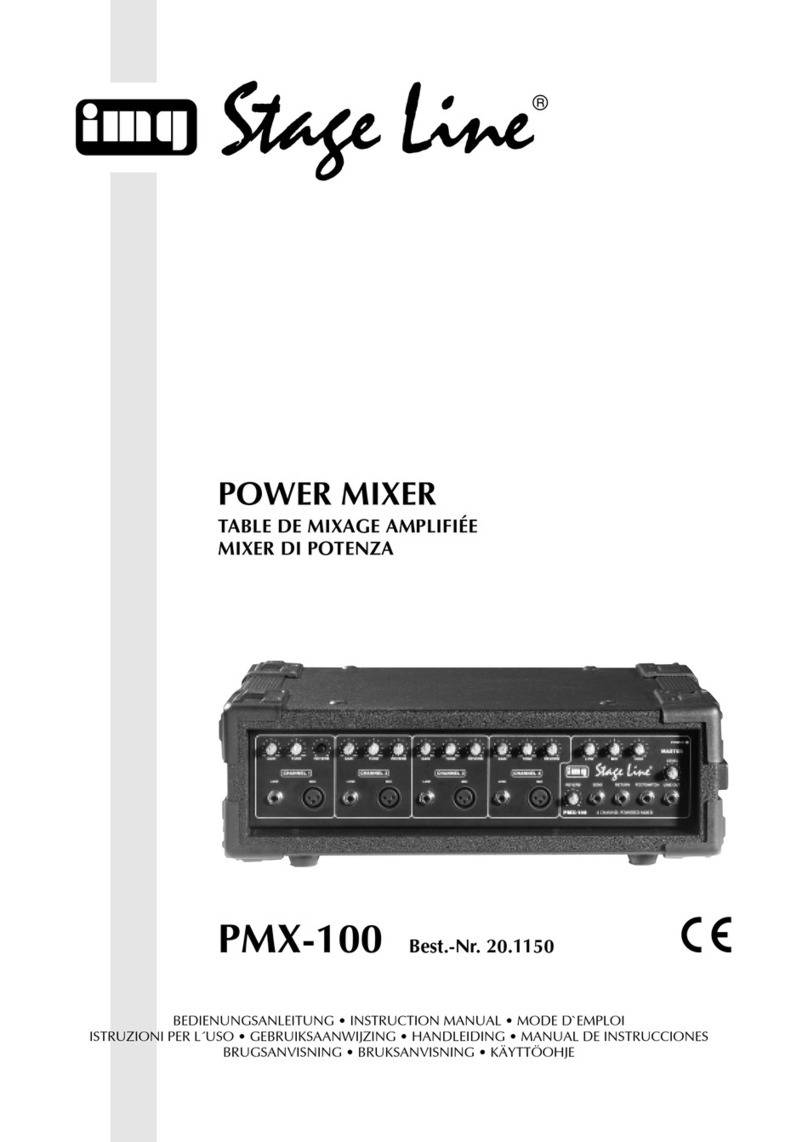
IMG STAGE LINE
IMG STAGE LINE PMX-100 User manual

IMG STAGE LINE
IMG STAGE LINE PA-6040MPX User manual
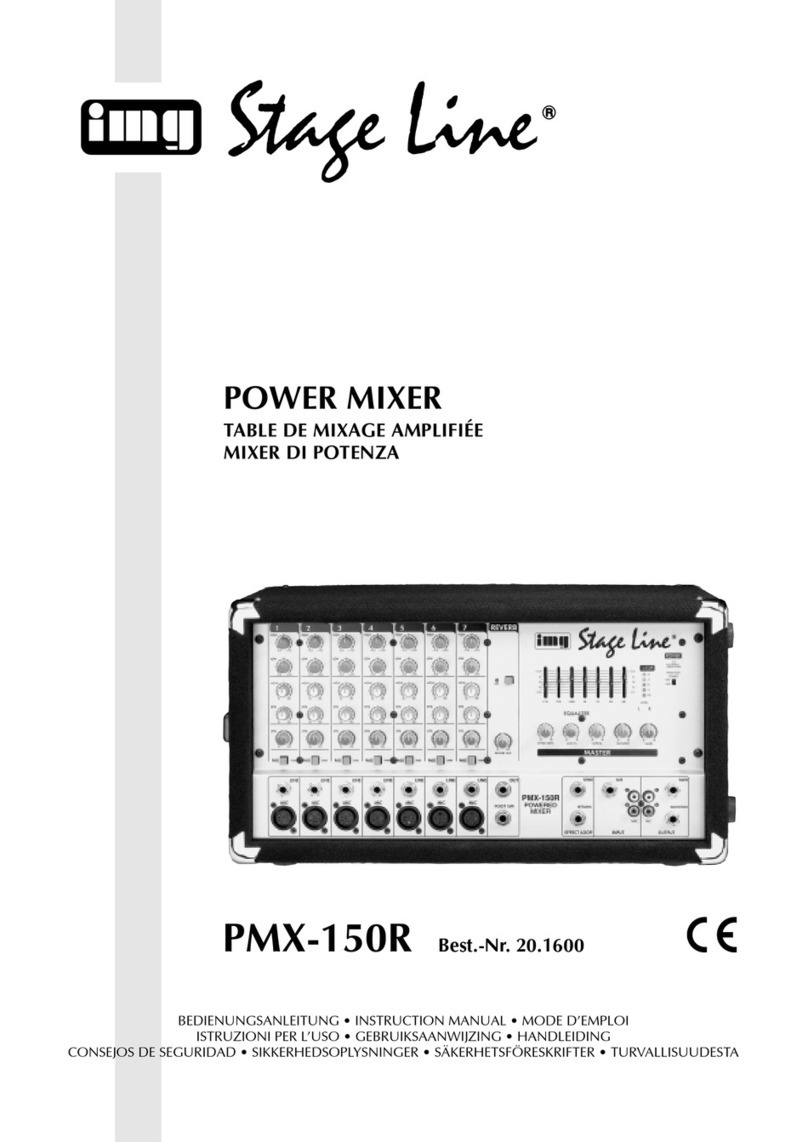
IMG STAGE LINE
IMG STAGE LINE PMX-150R User manual

IMG STAGE LINE
IMG STAGE LINE PMX-400 User manual

IMG STAGE LINE
IMG STAGE LINE MPX-808 User manual

IMG STAGE LINE
IMG STAGE LINE 20.0790 User manual
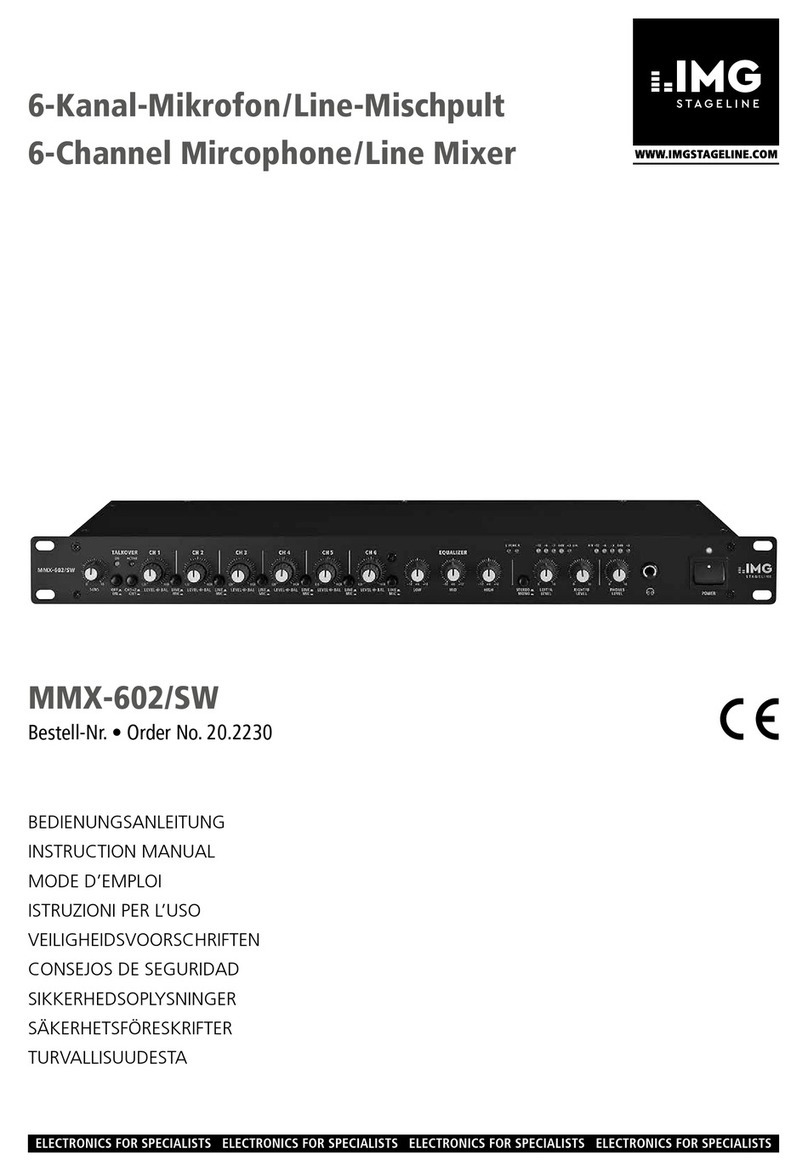
IMG STAGE LINE
IMG STAGE LINE MMX-602/SW User manual

